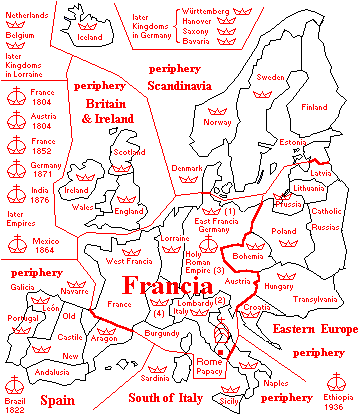

The historically central kingdoms of Francia, besides
These were all part of the Empire of Charlemagne. (Lorraine was only briefly a separate kingdom and then became one of the Stem Duchies of Germany.) The Periphery of Francia thus means the surrounding kingdoms. These naturally fall into six groups.
Outremer ("across the sea"), however, considered as part of Mediaeval Romania, and mostly Orthodox or Islâmic in faith, was a kind of colony, and a temporary one, of Francia, not strictly part of the "periphery." All the parts of it ended up conquered by the Turks.
Culturally, the Periphery of Francia is distinguished by the same
characteristics detailed for Francia, i.e. the
original jurisdiction of the ![]() Catholic Church, the use of the Latin language and alphabet, etc.
Some of these areas seem more peripheral than others. Spain became the
center of European power in the 16th century, and Britain in the 19th.
All the great wars of the 16th, 17th, 18th, 19th, and 20th centuries, however,
originated in the Core of Francia and then drew in the Peripheral states. An
exception to all this was when Scandinavia was the center, if not of
European power, certainly of the most energetic of European events. That
stretched from the 9th to the 11th centuries, the "Second Dark Age." The Scandinavians of that
period, Vikings (then Normans) in the West and Varangians (then Russians) in the
East, were still pagan, and their raids and conquests were a threat everywhere
in Francia. Christianization in the 10th and 11th centuries largely brought the
threat to a close, except for the more conventional conquests of the Normans and
Russians.
Catholic Church, the use of the Latin language and alphabet, etc.
Some of these areas seem more peripheral than others. Spain became the
center of European power in the 16th century, and Britain in the 19th.
All the great wars of the 16th, 17th, 18th, 19th, and 20th centuries, however,
originated in the Core of Francia and then drew in the Peripheral states. An
exception to all this was when Scandinavia was the center, if not of
European power, certainly of the most energetic of European events. That
stretched from the 9th to the 11th centuries, the "Second Dark Age." The Scandinavians of that
period, Vikings (then Normans) in the West and Varangians (then Russians) in the
East, were still pagan, and their raids and conquests were a threat everywhere
in Francia. Christianization in the 10th and 11th centuries largely brought the
threat to a close, except for the more conventional conquests of the Normans and
Russians.
My sources for all these tables are often given with the specific tables. A discussion of general sources is given under Francia.
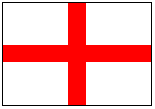 England,
England,
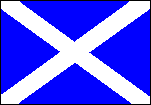 Scotland
Scotland 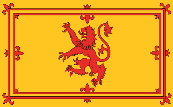 ,
,
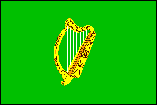 Ireland
Ireland 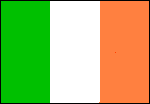 , and the
, and the
 United Kingdom
United Kingdom 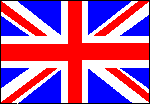 ,
,
445 AD-Present
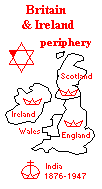 The Roman withdrawal
from Britain left the island outside of history until literate Anglo-Saxon
kingdoms emerged. Three kingdoms of Angles (Northumbria, Mercia, & East
Anglia), three of Saxons (Essex, Sussex, & Wessex), and one of the Jutes
(Kent) eventually fell to a Kentish King of Wessex, Egbert, who had spent time
in exile at the court of Charlemagne. Meanwhile,
these invaders had converted to Christianity and become literate.
The Roman withdrawal
from Britain left the island outside of history until literate Anglo-Saxon
kingdoms emerged. Three kingdoms of Angles (Northumbria, Mercia, & East
Anglia), three of Saxons (Essex, Sussex, & Wessex), and one of the Jutes
(Kent) eventually fell to a Kentish King of Wessex, Egbert, who had spent time
in exile at the court of Charlemagne. Meanwhile,
these invaders had converted to Christianity and become literate. 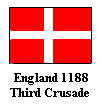
This was due to the mission of St. Augustine, who was sent by Pope Gregory the Great and founded the see of Canterbury. Meanwhile, however, the rest of the British Isles had already been converted to Christianity. Ireland, which was never Roman and was converted by St. Patrick in the 5th century, developed its own literate Christian culture and, in the person of St. Columba in the 6th century, proceeded to proselytize Scotland. Unfortunately, Ireland was never politically unified enough to follow cultural and religious influence with political power, or to resist incursions from Danes or Normans, or ambitious English dynasties, when they came. The Kings of all Ireland, as opposed to the kings of what later became counties (Munster, Connacht, etc.), were the "High Kings" (Ard Ri). They drew together the smaller kingdoms of the island, but a permanently unified Kingdom of Ireland was never fully established. The reign of Brian Baru, perhaps the high point of Irish unity and power, also seems to be the end of effective Irish organization. Henry II of England, whose Normans began to overrun the island, styled himself "Lord of Ireland" (c. 1172), and in 1541 Henry VIII altered this to "King of Ireland."
The kings of Scotland, starting, under English influence, nearly as
early as the kings of a united England, ultimately succeeded to the throne of
England itself.  Wales, in effect
the last piece of Roman Britain, was annexed by England as a principality. The
heir to the throne of Britain is still styled the Prince of Wales. Although
Britain was never an "empire," Queen Victoria did assume the imperial title for
India, as successor to
the Moghuls, in 1876.
The House of York is shown in white as a reminder that York was the White Rose,
as Lancaster was the Red Rose, in the War of the Roses. Since the House of
Stuart was Scottish, it is shown in yellow for Scotland.
Wales, in effect
the last piece of Roman Britain, was annexed by England as a principality. The
heir to the throne of Britain is still styled the Prince of Wales. Although
Britain was never an "empire," Queen Victoria did assume the imperial title for
India, as successor to
the Moghuls, in 1876.
The House of York is shown in white as a reminder that York was the White Rose,
as Lancaster was the Red Rose, in the War of the Roses. Since the House of
Stuart was Scottish, it is shown in yellow for Scotland.
The earliest history and dates for Ireland are legendary and speculative. Niall Noígillach "of the Nine Hostages" may have lived in the previous century, and the dates given for St. Patrick depend on identifying him with a "Palladius," who is mentioned by a contemporary chronicler as having been sent by the Pope as the first bishop of the Irish. If Patrick was not this person, he would have lived shortly thereafter.
I have found an outstanding source for all British and Irish rulers, and some
other royalty and nobility, in The Mammoth Book of British Kings and
Queens by Mike Ashley [Carroll & Graf Publishers, Inc., New York, 1998,
1999]. The treatment of Anglo-Saxon and Irish kings now has been corrected and
updated using this book down to the end of the Plantagenets. The Irish (Gaelic)
spelling of many of the names of the High Kings of Ireland, however, is derived
from Bruce R. Gordon's Regnal
Chronologies. I have only given two English kingdoms, Kent and Wessex,
because these are the first and the last ones, respectively -- and there is no
room for the parallel listing of more. Other kingdoms, Essex and Mercia, may be
seen temporarily holding Kent. As in Ireland, what were originally local
kingdoms simply became counties in the later united monarchy.
| Kings of Kent Jutes |
Kings of Wessex Saxons |
High Kings of Ireland | |||
|---|---|---|---|---|---|
| Niall Noígillach of the Nine Hostages | 379-405, Tara | ||||
| Dathi/Nath I | 405-428 | ||||
| Hengest | c.455-488 | Lóeguire macNéill | 429-463 | ||
| St. Patrick, mission to Ireland, 432; d. 461 | |||||
| Oisc, Oeric (Aesc) | c.488-516 | Ailill Motl mac Nath I | 463-483 | ||
| Octha | c.516-540 | Cerdic | c.538-554 | Lugaid macLóeguiri O'Néill | 483-507 |
| Muirchertach macErcae O'Néill | 507-534 | ||||
| Eormenric | c.540-580 | Cynric | c.554-581 | Tuathal Máelgarb macCorpri Cáech O'Néill | 534-544 |
| Diarmait macCerbaill O'Néill | 544-565 | ||||
| St. Columba, mission to Scotland, 563; d. 597 | |||||
| St. AEthelbert I | c.580-616 | Ceawlin | c.581-588 d.c.589 | Domnall macMuirchertaig O'Néill | 565-566 |
| Forggus macMuirchertaig O'Néill | 565-566 | ||||
| Ainmere macSátnai O'Néill | 566-569 | ||||
| Báetán macMuirchertaig O'Néill | 569-572 | ||||
| Eochaid macDomnaill O'Néill | 569-572 | ||||
| Báetán macNinnedo O'Néill | 572-581 | ||||
| Ceol | 588-594 | Aed macAinmerech O'Néill | 581-598 | ||
| Ceolwulf | 594-611 | Aed Sláine macDiarmato O'Néill | 598-604 | ||
| Colmán Rímid macBáetáin O'Néill | rival, 598-604 | ||||
| Aed Uaridnach macDomnaill O'Néill | 604-612 | ||||
| St. Augustine of Canterbury, mission to England, 597; d. 605 | |||||
| Eadbald | 616-640 | Cynegils | 611-643 | Máel Cobo macAedo O'Néill | 612-615 |
| Suibne Menn macFiachnai O'Néill | 615-628 | ||||
| Domnall macAedo O'Néill | 628-642 | ||||
| Earconbert | 640-664 | Cenwealh | 643-672 | Conall Cóel macMáele Cobo O'Néill | 642-654 |
| Cellach macMáele Cobo O'Néill | jointly, 642-658 | ||||
| Diarmait macAedo Sláine O'Néill | jointly, 656-665 | ||||
| Blathmac macAedo Sláine O'Néill | jointly, 656-665 | ||||
| Sechnussach macBlathmaic O'Néill | 665-671 | ||||
| Egbert I | 664-673 | Seaxburh | Queen, 672-673 |
Cenn Fáelad macBlathmaic O'Néill | 671-675 |
| Hlothhere | 673-685 | Aescwine | 674-676 | Finsnechtae Fledach macDúnchada O'Néill | 675-695 |
| Centwine | 676-685, d.? | ||||
| Eadric | 685-686 | ||||
| 686-687 | Caedwalla (Peter) |
685-687 d.688 in Rome | |||
| Mul | 686-687 | Ine | 688-726 d.728 in Rome | ||
| Sigehere | King of Essex, 687-688 | ||||
| Oswine | 688-690 | ||||
| Swaeflheard | 689-692 | ||||
| Wihtred | 691-725 | Loingsech macOengus O'Néill | 695-704 | ||
| Congal Cinn Magir macFergus Fánat O'Néill | 704-710 | ||||
| Fergal macMáele Dúin O'Néill | 710-722 & Ailech | ||||
| Fogartach macNéill O'Néill | 722-724 | ||||
| Cináed mac Irgalaig | 724-728 | ||||
| AEthelbert II | 725-748, c.754-762 |
AEthelheard | 728-740 | Flaithbbertach macLoingsig O'Néill | 724-734 d.765 |
| Aed Allán macFergal O'Néill | 734-743 | ||||
| Eadberht I | 725-c.762 | Domnall Midi O'Néill | 743-763 | ||
| Ealric | 725-? | ||||
| Eardwulf | c.748-754 | Cuthred | 740-756 | ||
| Sigered | 759-763 | Sigebert | 756-757 | ||
| Ealhmund | 762-764, c.784-785 |
Cynewulf | 756-786 | ||
| Heaberht | 764-c.771 | Niall Frossach macFergal O'Néill | 763-770 d.778 | ||
| Egbert II | 764-c.784 | Donnchad Midi macDomnaill Midi O'Néill | 770-797 | ||
| Offa | King of Mercia, 757-796 |
Beorhtric | 786-802 | ||
| c.785-796 | |||||
| Eadberht II | 796-798 | Aed Oirdnide macNéill Frossach O'Néill | 797-819 | ||
| Cuthred of Mercia | 798-807 | Egbert | 802-839 | Conchobar macDonnchado Midi O'Néill | 819-833 |
| Mercia, 807-823 | King of England, 829-839 |
Niall Caille macAedo Oirdnide O'Néill | 833-846 | ||
| Baldred | 823-825 | ||||
| 825-839 | AEthelwulf | England, 839-855 | |||
| Kings of Gwynedd | |
|---|---|
| Rhodri the Great | 844-878 |
| Anarawd ap Rhodri | 878-916 |
| Idwal the Bald | 916-942 |
| Hywel Dda | King of Deheubarth, 920-950 |
| 942-950 | |
| Iago ab Idwal | 950-979 |
| Ieuaf ab Idwal | 950-969 |
| Hywel ap Ieuaf | 974-985 |
| Cadwallon ap Ieuaf | 985-986 |
| Maredudd ap Owain | King of Deheubarth, 986-999 |
| 986-999 | |
| Cynan ap Hywel | 999-1005 |
| Llywelyn ap Seisyll | 1005-1023 |
| Iago ap Idwal | 1023-1039 |
| Gruffydd ap Llywelyn | 1039-1063 |
| Bleddyn ap Cynfyn | 1063-1075 |
| Rhiwallon ap Cynfyn | 1063-1070 |
| Trahern ap Caradog | 1075-1081 |
| Gruffydd ap Cynan | 1081-1137 |
| Owain Gwynedd | 1137-1170 |
| Maelgwyn ab Owain | 1170-1173 |
| Dafydd ab Owain | 1170-1195, d.1203 |
| Rhodri ab Owain | 1170-1190, d.1195 |
| Llywelyn the Great | 1195-1240 |
| Prince of Wales, 1216-1240 | |
| Dafydd ap Llywelyn | 1240-1246 |
| Llywelyn the Last ap Gryffydd |
1246-1282 |
| Prince of Wales, 1258-1282 | |
| Owain ap Gruffydd | 1246-1255, 1277-1282 |
| Dafydd ap Gruffydd | 1282-1283 |
| Conquest by England, 1283 | |
| Edward, II of England |
Prince of Wales, 1301-1307 |
| King of England, 1307-1327 | |
Wales consisted of a number of small kingdoms since at least the 5th century. Gwynedd and Deheubarth became the principal states, with Gwynedd eventually predominating. A united and independent Wales, however, only survived briefly, until Edward I of England definitively annexed the country in 1283. The capital of Wales now is Cardiff, in the south, but Edward built Caernarvon Castle in Gwynedd to control the country. Edward is supposed to have promised the Welsh in 1284 that he would provide a prince for them born in Wales who did not speak a word of English. He then produced his son Edward, just born at Caenarvon, who of course didn't speak a word of anything. Edward was formally invested as Prince of Wales in 1301.

The descent of the Tudors from Welsh royalty is shown, but there are some
uncertainties about this. The Mammoth Book of British Kings and Queens
gives it [p.331] as though unproblematic, but Brian
Tompsett's Royal and Noble genealogy gives an alternate descent and
discusses other uncertainties. While the Welsh derivation of the Tudors is
beyond doubt, one suspects that Henry VII or others might not be above
manufacturing a royal version of the descent. While the main line of the
Tudors died out, it will be noted below that all subsequent British royality is
descended from Henry VII through his daughter Margaret and her husband, King
James IV of Scotland.
| Kings of England Saxons |
Kings of Scotland | High Kings of Ireland | |||
|---|---|---|---|---|---|
| AEthelwulf | 839-855 | Kenneth MacAlpin |
840-858 | Máel Sechnaill macMáele Ruanaid O'Néill | 846-862 Mide |
| AEthelbald | 855-860 | Donald I | 858-863 | ||
| AEthelbert | 860-865 | Constantine I | 863-877 | Aed Findliath macNéill Caille O'Néill | 862-879 Ailech |
| AEthelred I | 865-871 | Aed | 877-878 | ||
| Alfred the Great | 871-899 | Eochaid & Giric I | 878-889 | Flann Sionna macMáele Sechnaill O'Néill | 879-916 Mide |
| Edward the Elder | 899-924 | Donald II | 899-900 | Niall Glúndubh macAedo Findliath O'Néill | 916-919 Ailech |
| Elfweard | 924 | Constantine II | 900-943 | Donnchad Donn macFlann O'Néill | 919-944 |
| Athelstan | 924-939 | ||||
| Edmund I | 939-946 | Malcolm I | 943-954 | Ruaidrí ua Canannáin | rival, 944-950 |
| Eadred | 946-955 | Indulf | 954-962 | Congalach Cnogba macMáel Mithig O'Néill | 944-956 |
| Edwy/Eadwig the Fair | 955-959 | Dubh | 962-c.966 | Domnall macMuirchertaig O'Néill | 956-980 |
| Edgar | 959-975 | Cuilean Ring | c.966-971 | ||
| Edward the Martyr |
975-978 | Kenneth II | 971-995 | Máel Sechnaill macDomnaill O'Néill | 980-1002, 1014-1022 |
| AEthelred II the Unready | 978-1013, 1014-1016 |
Constantine III the Bald | 995-997 | ||
| Danish occupation, 1013-1014 | Kenneth III | 997-1005 | Brian Bóruma macCennétig, Brian Boru |
Munster, 976-1014; High King, 1002-1014 | |
| Edmund II Ironside | 1016 | Giric II | 997-1005 | ||
| Danes | Malcolm II | 1005-1034 | |||
| Canute the Great | 1016-1035 | Killed in victory over Danes at Clontarf, 1014 | |||
| King of Denmark 1018-1035 |
Donnchad MacBrian | Munster, 1022-1063; d.1064 | |||
| Harold I | 1035-1040 | Duncan I | 1034-1040 | ||
| Hardecanute | King of Denmark 1035-1042 | ||||
| 1040-1042 | |||||
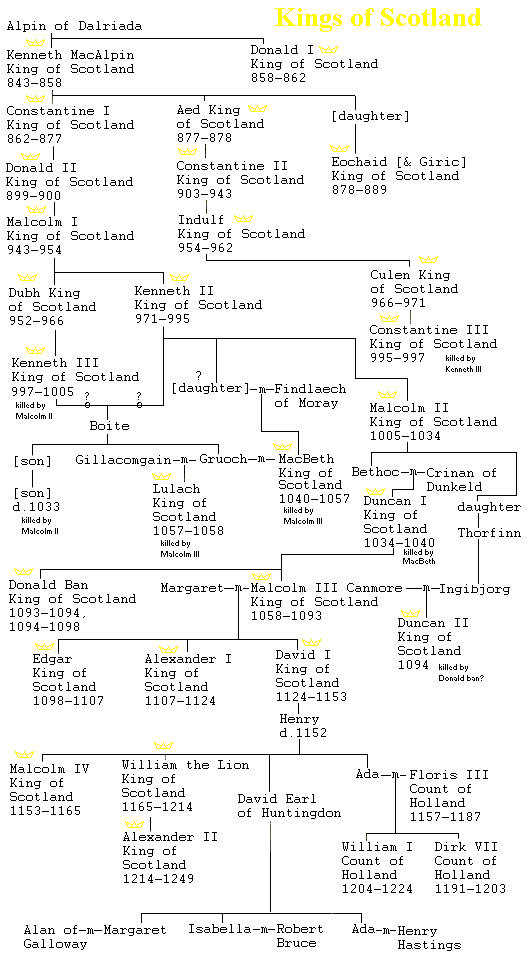
| Saxons | MacBeth | 1040-1057 | Diarmait MacMáil na mBó | 1042-1072 Leinster | |
|---|---|---|---|---|---|
| Edward the Confessor |
1042-1066 | ||||
| Harold II | 1066 | Lulach | 1057-1058 | ||
| Edgar the Aetheling | 1066 | Malcolm III Canmore |
1058-1093 | ||
| Normans | |||||
| William I the Conqueror |
the Bastard, Duke of Normandy, 1035-1087 |
Toirdelbach O'Brien | 1063-1086 Munster, 1072-1086 High King | ||
| 1066-1087 | Donald Bane | 1093-1094, 1094-1097, d.1099 | |||
| William II | 1087-1100 | Edmund | 1094-1097, d.? |
Domnall macArdgar O'Lochlainn O'Néill | 1090-1121 Ailech, Cenél |
| Duncan II | 1094 | Muirchertach II MacToirdelbaig O'Brien | 1086-1119 Munster | ||
| Henry I | 1100-1135 | Edgar | 1097-1107 | ||
| Alexander I | 1107-1124 | Toirrdelbach (Turlogh) macRuaidrí na Saide
Buide ua Conchobair |
1106-1156 Connacht, 1121-1135, 1141-1150 High King, d.1156 | ||
| Stephen | 1135-1154 | David I the Saint | 1124-1153 | ||
| Plantagenets | |||||
| Henry II | 1154-1189 | Malcolm IV | 1153-1165 | Muirchertach (Murtagh) macNéill macLochlainn | 1136-1166 Ailech, 1150-1166 High King |
| Lord of Ireland, 1175 | |||||
| Richard I the Lionheart |
1189-1199 | William the Lion | 1165-1214 | Ruaidrí macToirrdelbaig, Rory O'Connor | 1156-1183 Connacht, 1166-1175 last High King, d.1198 |
| Third Crusade, 1189-1192 | Conchobar | 1183-1189 Connacht | |||
| John Lackland | 1199-1216 | Cathal | 1189-1200 Connacht | ||
| Henry III | 1216-1272 | Alexander II | 1214-1249 | English rule | |
| Alexander III | 1249-1286 | Brian Catha an Duin | 1258-1260 | ||
| Margaret Maid of Norway |
1286-1290 | English rule | |||
| Interregnum, 1290-1292 | |||||
| John Baliol | 1292-1296 d.1315 | ||||
| 1272-1307 | Edward I | 1296-1306 | |||
| Edward II | 1307-1327 | Robert I the Bruce |
1306-1329 | Edward de Bruce | 1316-1318 |
| Edward III | 1327-1377 | David II | 1329-1370 | English rule | |
| Hundred Years War, 1337-1453 | |||||
| Richard II | 1377-1399, d.1400 | ||||
The Norman Conquest of England profoundly altered the nature and direction of English, and British, history. The cultural change may now be the most conspicuous. English has a larger vocabulary than most languages because the great number of French words introduced by the Normans doubled up with original Old English words -- for example "sheep" is from Old English while "mutton" is from French; "watch" is from Old English, "hour" is from French, and, just for good measure, "clock" is from Danish. Since there is usually not much point in having two words that mean exactly the same thing, the meaning of the doubled words varies somewhat, expanding nuance. Grammatically, English may be said to have French nouns and German verbs. Since the French noun system is simpler than the German (or Old English), and the German verb system is simpler than the French, English benefits in simplicity each way -- if, for some reason, simplicity is to be valued -- it does make the language easier to learn (if not to spell).
On the political side, the Norman Conquest unified the administration of
England, preventing the kind of feudal fragmenation that troubled France for so
long. The centralization of government at the same time made it the focus of
efforts to limit its power, first by the nobility (resulting in the Magna
Carta), later by well-to-do merchants (resulting in the English Revolution).
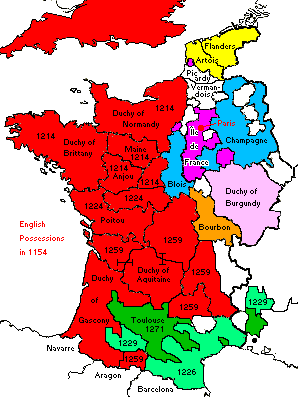 Constitutionally, this
gave England a head start over all the rest of Europe in the evolution of modern
government. The centralization of power also depoliticized land ownership,
loosening the ties of feudalism, including serfdom. Something approaching
private property and a free labor market soon gave England an economic advantage
that grew and lasted into the 20th century (see Alan MacFarlane, The Origins
of English Individualism: The Family, Property and Social Transition [Basil
Blackwell, Oxford, 1978]).
Constitutionally, this
gave England a head start over all the rest of Europe in the evolution of modern
government. The centralization of power also depoliticized land ownership,
loosening the ties of feudalism, including serfdom. Something approaching
private property and a free labor market soon gave England an economic advantage
that grew and lasted into the 20th century (see Alan MacFarlane, The Origins
of English Individualism: The Family, Property and Social Transition [Basil
Blackwell, Oxford, 1978]).
The failure of male heirs to William the Conqueror's line resulted in some
conflict, until Henry (II) of Anjou was firmly in place
as the first of the Plantagenets. Henry brought with him additional French
territory, and then obtained a large part of the whole Kingdom of France by
marrying Eleanor, the hieress of Aquitaine and Gascony,
who had recently divorced King Louis VII of France. This English "empire" in
France dominated the history of both countries for some time thereafter. The
incompetent King John not only was forced by the nobility into recognizing
rights long honored as the origin of English constitutionalism, but his loss of
English possessions in France north of the Loire (hence "Lackland") put the
French Monarchy on course for the unification and centralization of political
power in France -- whose success made France the predominant power in Europe in
the 17th century but whose drawbacks ultimately produced the French Revolution.
Meanwhile, some attention could be paid to the rest of the British Isles, where
Ireland gradually came under English control, Wales was annexed by Edward I, and
then Edward also briefly acquired Scotland, where he exploited offers of
mediation in the succession dispute of 1290-1292. This episode is rather badly
(even falsely) represented in the otherwise rather good movie Braveheart
(Best Picture Oscar for 1995).

| Lancaster | Stuart | ||
|---|---|---|---|
| Robert II Stuart | 1370-1390 | ||
| Henry IV | 1399-1413 | Robert III | 1390-1406 |
| Henry V | 1413-1422 | James I | 1406-1437 |
| Henry VI | 1422-1461 1470-1471 |
James II | 1437-1460 |
| Wars of the Roses, 1455-1485 | |||
| York | |||
| Edward IV | 1461-1470 1471-1483 |
James III | 1460-1488 |
| Edward V | 1483 | ||
| Richard III | 1483-1485 | ||
| Tudor | |||
| Henry VII | 1485-1509 | James IV | 1488-1513 |
| Henry VIII | 1509-1547 | James V | 1513-1542 |
| King of Ireland, 1541 | |||
| Edward VI | 1547-1553 | Mary Queen of Scots |
1542-1567 d. 1587 |
| Mary I | 1553-1558 | ||
| Elizabeth I | 1558-1603 | ||
| Stuart | |||
| 1603-1625 | James VI of Scotland James I of England |
1567-1625 | |
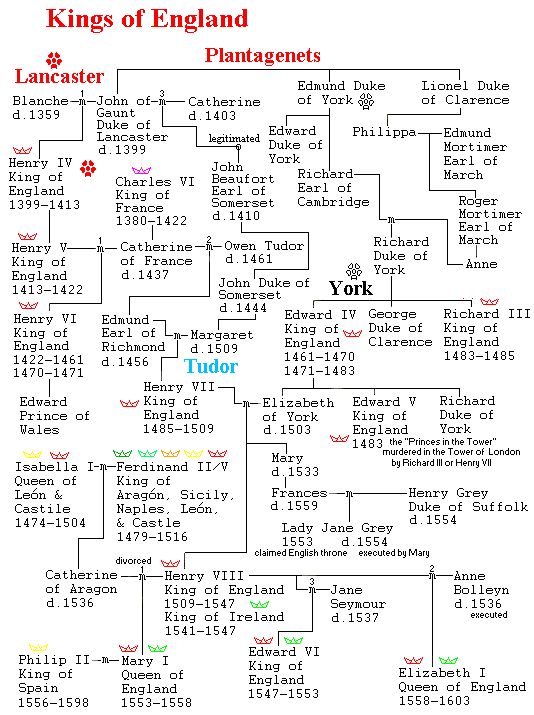
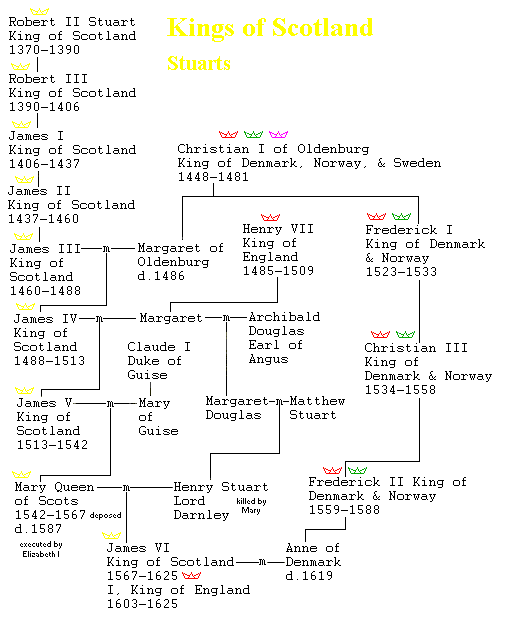
| Stuart | |
|---|---|
| Charles I | 1625-1649 |
| Civil War, 1640-1649; Commonwealth, 1649-1653; First Dutch War, 1652-1654; Protectorate, 1653-1660 | |
| Oliver Cromwell | Lord Protector, 1653-1658 |
| Richard Cromwell | 1658-1660, d.1712 |
| Charles II | 1660-1685 |
| Second Dutch War, 1664-1667; New Amsterdam acquired, becomes New York, 1664; Third Dutch War, 1672-1674 | |
| James II | 1685-1688 |
| [interregnum] | 1688-1689 |
| Mary II | 1689-1694 |
| William III | Stadholder of the Netherlands, 1672-1702 |
| 1689-1702 | |
| War of the League of Augsburg, 1688-1697; War of the Spanish Succession, 1701-1713 | |
| Anne | 1702-1714 |
This is where the undercurrent of religion comes in, for
Charles had become sympathetic to Catholicism and began to tilt towards France
(with the help of a secret subsidy, including women, from Louis XIV) and against
the Protestant Netherlands, which Louis had invaded (1672). Otherwise, the
exhuberance of the Restoration, and the infamous philandering of Charles, all
look more libertine than Catholic. 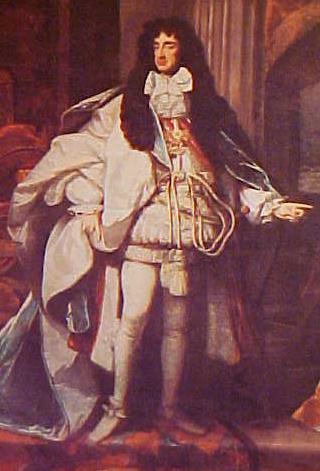 Some sense of this can be gleaned from the movie Restoration
[1994]. However, actor Sam Niell did not make a very good Charles II. Charles,
very tall and dark, with long black hair (click on image for larger version),
not to mention productive of multiple illegitimate children,
would be more like a dead ringer for "shock jock" radio personality Howard
Stern. Charles did convert to Catholicism before his death, and then his openly
Catholic brother, James II, became King. This produced the beginnings of modern
political parties: The Tories, who were for James, and the
Whigs, against him. While James talked of no more than toleration for
Catholics, his actions soon were for the persecution and suppression of
Protestants. This was more or less tolerable as long as James's heirs were his
Protestant daughters, Mary and Anne; but when he fathered a (Catholic) son on
his new (Catholic) wife, Mary of Modena, resistance began
to stiffen. William of Orange, husband of Mary, landed with a Dutch Army, the
British Army went over to him, and James fled -- a bloodless transaction
consequently called the "Glorious Revolution." Finding Catholic sympathy and
support in Ireland (and, of course, from France), James was finally defeated at
the Battle of the Boyne in 1689. William could then go on to organize the great
alliances against France in the War of the League of Augsburg (1688-1697) and
the War of the Spanish Succession (1701-1713). Lack of heirs continued to
bedevil the dynasty. With Anne, this was not from lack of trying. She had 14
children, evey single one of whom predeceased her. With a sad irony, Anne was
the last British Monarch who exercised what were believed to be the healing
powers of the Royal Touch -- though by Anne's day this was supposed only to be
effective for scrofula, tuberculosis of the lymph glands. Presumably,
this is not what afflicted her children. Unwilling to countenance the Catholic
Stuart Pretenders (the "Jacobites"), Parliament brought in George I of Hanover,
a great-grandson of James I through his daughter Elizabeth and granddaughter
Sophie.
Some sense of this can be gleaned from the movie Restoration
[1994]. However, actor Sam Niell did not make a very good Charles II. Charles,
very tall and dark, with long black hair (click on image for larger version),
not to mention productive of multiple illegitimate children,
would be more like a dead ringer for "shock jock" radio personality Howard
Stern. Charles did convert to Catholicism before his death, and then his openly
Catholic brother, James II, became King. This produced the beginnings of modern
political parties: The Tories, who were for James, and the
Whigs, against him. While James talked of no more than toleration for
Catholics, his actions soon were for the persecution and suppression of
Protestants. This was more or less tolerable as long as James's heirs were his
Protestant daughters, Mary and Anne; but when he fathered a (Catholic) son on
his new (Catholic) wife, Mary of Modena, resistance began
to stiffen. William of Orange, husband of Mary, landed with a Dutch Army, the
British Army went over to him, and James fled -- a bloodless transaction
consequently called the "Glorious Revolution." Finding Catholic sympathy and
support in Ireland (and, of course, from France), James was finally defeated at
the Battle of the Boyne in 1689. William could then go on to organize the great
alliances against France in the War of the League of Augsburg (1688-1697) and
the War of the Spanish Succession (1701-1713). Lack of heirs continued to
bedevil the dynasty. With Anne, this was not from lack of trying. She had 14
children, evey single one of whom predeceased her. With a sad irony, Anne was
the last British Monarch who exercised what were believed to be the healing
powers of the Royal Touch -- though by Anne's day this was supposed only to be
effective for scrofula, tuberculosis of the lymph glands. Presumably,
this is not what afflicted her children. Unwilling to countenance the Catholic
Stuart Pretenders (the "Jacobites"), Parliament brought in George I of Hanover,
a great-grandson of James I through his daughter Elizabeth and granddaughter
Sophie.
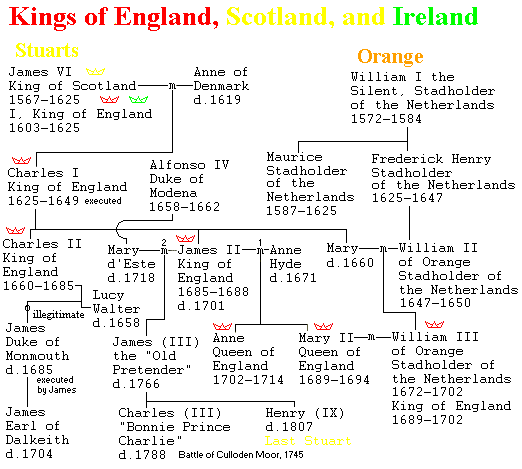
 The Union of England and
Scotland in 1707 produced the "United Kingdom," with a single Parliament, and
the Union Flag, at left. A separate Scottish Parliament has been recently
reestablished.
The Union of England and
Scotland in 1707 produced the "United Kingdom," with a single Parliament, and
the Union Flag, at left. A separate Scottish Parliament has been recently
reestablished.
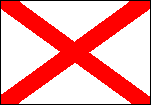 Formal Union with
Ireland in 1801 added the familiar diagonal red stripes to the present Union
Flag. These were based on red "saltire" cross of the Fitzgerald family, now a
very old Irish family (cf. John Fitzgerald
Kennedy) but originally among the Normans who conquered Ireland for England
in the 12th century. Thus, the cross is usually not viewed as a genuine Irish
national symbol.
Formal Union with
Ireland in 1801 added the familiar diagonal red stripes to the present Union
Flag. These were based on red "saltire" cross of the Fitzgerald family, now a
very old Irish family (cf. John Fitzgerald
Kennedy) but originally among the Normans who conquered Ireland for England
in the 12th century. Thus, the cross is usually not viewed as a genuine Irish
national symbol.
Subsequent Kings are listed with their Prime Ministers. There is some uncertainty here about the Party affiliations of some of the early Prime Ministers. The Encyclopaedia Britannica says, "There were no formal political parties in the 18th century...nor was there a formal opposition in Parliament, and opposition to the king's ministry was regarded as factious and even traitorous." This does seem to introduce an element of vagueness into many of the Governments. There is also some disagreement and confusion sometimes about who the Prime Ministers were, since the title wasn't used until the 20th Century. Thus, there are different versions of when William Pitt the Elder was, if ever, Prime Minister. These assignments are based on Langer's An Encyclopedia of World History, mentioned above, the Britannica descriptions, the assignments and descriptions at http://britannia.com/gov/primes/ (which lists Palmerston as a Tory, which he certainly was not after 1830), the Encyclopedia of World History edited by Patrick K. O'Brien [Facts on File, 2000, p.522], and The World Amanac and Books of Facts, 2001 [World Almanac Books, 2001, p.490]. The latter two sources list Coalition ministries, which were especially common in wartime. Be that as it may, Lloyd George was a Liberal, and Winston Churchill was a Conservative, and that is how they are given here.
| Hanover | |||
|---|---|---|---|
| George I | 1714-1727 | Prime Ministers | |
| Whig/Liberal | Tory/Conservative | ||
| Sir Robert Walpole | 1721-1742 | ||
| George II | 1727-1760 | ||
| War of the Austrian Succession, 1740-1748 | |||
| Lord John Carteret/ Earl of Wilmington |
1742-1743 | ||
| Henry Pelham | 1743-1754 | ||
| Duke of Newcastle | 1754-1756, 1757-1762 | ||
| Duke of Devonshire | 1756-1757 | ||
| Seven Years War, 1756-1763 | |||
| George III | 1760-1820 | Earl of Bute | 1762-1763 |
| George Grenville | 1763-1765 | ||
| Marquis of Rockingham | 1765-1766, 1782 | ||
| William Pitt the Elder |
1766-1768 | ||
| Duke of Grafton | 1768-1770 | ||
| Lord Frederick North | 1770-1782 | ||
| American Revolution, 1775-1783 | |||
| Earl of Shelburne | 1782-1783 | ||
| Duke of Portland | 1783, 1807-1809 | ||
| William Pitt the Younger |
1783-1801, 1804-1806 | ||
| Henry Addington | 1801-1804 | ||
| Lord William Grenville | 1806-1807 | ||
| Abolition of Slave Trade, 1807 | |||
| Spencer Perceval | 1809-1812 | ||
| Earl of Liverpool | 1812-1827 | ||
| George IV | 1820-1830 | ||
| George Canning | 1827 | ||
| Viscount Goderich | 1827-1828 | ||
| Duke of Wellington | 1828-1830, 1834 | ||
| Catholic Emancipation, 1829 | |||
| William IV | 1830-1837 | Earl Grey | 1830-1834 |
| First Reform Bill, 1832; Abolition of Slavery, 1833 | |||
| Viscount Melbourne | 1834, 1835-1841 | ||
| Sir Robert Peel | 1834-1835, 1841-1846 | ||
| Victoria Empress of India, 1876 |
1837-1901 | ||
| Abolition of Corn Laws, 1846 | |||
| Lord John Russell | 1846-1852, 1865-1866 | ||
| Earl of Derby | 1852, 1858-1859, 1866-1868 | ||
| Earl of Aberdeen | 1852-1855 | ||
| Crimean War, 1854-1856 | |||
| Viscount Palmerston | 1855-1858, 1859-1865 | ||
| Jewish Emancipation, 1858 | |||
| Second Reform Bill, 1867 | |||
| Benjamin Disraeli | 1868, 1874-1880 | ||
| William E. Gladstone | 1868-1874, 1880-1885, 1886, 1892-1894 | ||
| Third Reform Bill, 1884; First Home Rule Bill, 1886; Second Home Rule Bill, 1893 | |||
| Marquis of Salisbury | 1885-1886, 1886-1892, 1895-1902 | ||
| Boer War, 1899-1902 | |||
| Earl of Rosebery | 1894-1895 | ||
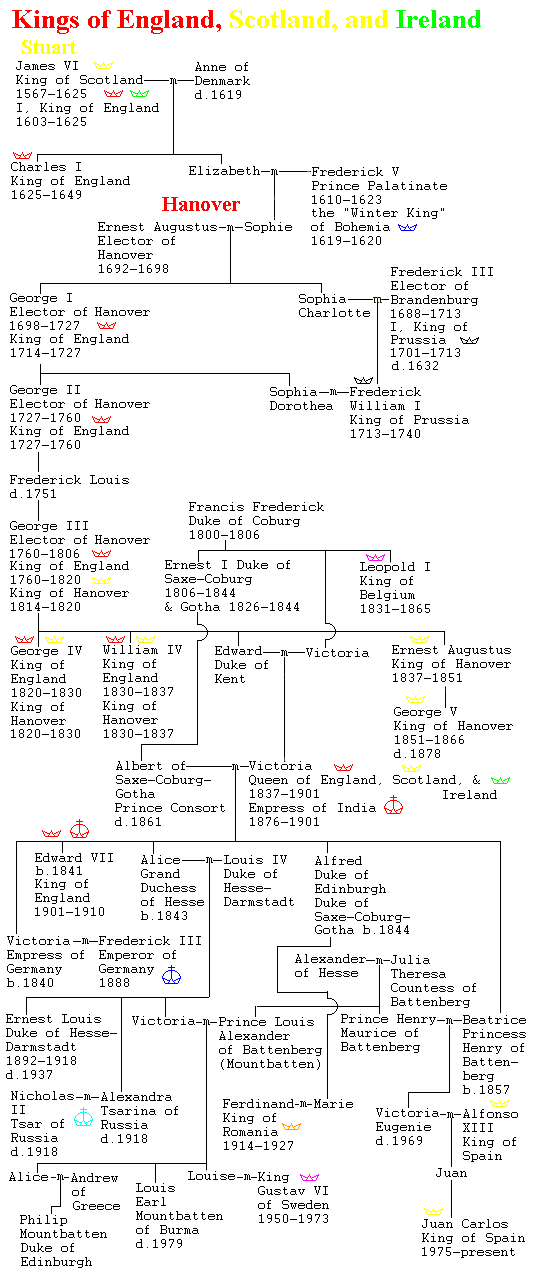
One of the great English political issues of the later 19th century was Irish
Home Rule. The Irish Parliament had been dissolved in 1801 and Irish members
elected to the British Parliament. Catholic emancipation in 1829 even meant that
Irish Catholics could be elected to Parliament. However, the Parliamentary
program of the Irish Members quickly became Irish independence. William
Gladstone's Liberal government fell over a Home Rule Bill for Ireland in 1886,
splitting the Liberal Party into Home Rule and Unionist factions.  After a second Home Rule Bill
was defeated in the House of Lords, Gladstone resigned in 1894 from his fourth
and last ministry. A Home Rule Bill was finally passed in 1914, but its
suspension for World War I resulted in open Irish rebellion in 1916 and years of
terrorism by the Irish Republican Army (IRA).
After a second Home Rule Bill
was defeated in the House of Lords, Gladstone resigned in 1894 from his fourth
and last ministry. A Home Rule Bill was finally passed in 1914, but its
suspension for World War I resulted in open Irish rebellion in 1916 and years of
terrorism by the Irish Republican Army (IRA). 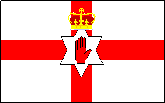 When Irish independence came,
it was compromised by partition, as the Protestants of Ulster secured a separate
regime for themselves. The "Red Hand of Ulster" flag was official until the
Ulster Parliament was itself abolished in 1972, in British response to the
"troubles" in Northern Ireland, which began with Catholic civil rights
demonstrations in 1968 and expanded into IRA bombings and Protestant
retaliation. Although several peace plans have been formally accepted by
Britain, the Irish Republic, and most factions in Ulster, it is not clear that
the situation is anywhere near real resolution. The recent economic awaking of
the Irish Republic
itself may help undercut some of the basically Marxist inspiration of the
IRA.
When Irish independence came,
it was compromised by partition, as the Protestants of Ulster secured a separate
regime for themselves. The "Red Hand of Ulster" flag was official until the
Ulster Parliament was itself abolished in 1972, in British response to the
"troubles" in Northern Ireland, which began with Catholic civil rights
demonstrations in 1968 and expanded into IRA bombings and Protestant
retaliation. Although several peace plans have been formally accepted by
Britain, the Irish Republic, and most factions in Ulster, it is not clear that
the situation is anywhere near real resolution. The recent economic awaking of
the Irish Republic
itself may help undercut some of the basically Marxist inspiration of the
IRA.
| Saxe-Coburg-Gotha (Windsor) | |||
|---|---|---|---|
| Edward VII | 1901-1910 | Prime Ministers | |
| Liberal | Labour | ||
| Tory/Conservative | |||
| Arthur J. Balfour | 1902-1905 | ||
| Sir Henry Campbell-Bannerman |
1905-1908 | ||
| Herbert H. Asquith | 1908-1916 | ||
| George V | 1910-1936 | ||
| Third Home Rule Bill, 1914; World War I, 1914-1918 | |||
| David Lloyd George | 1916-1919/ 1919-1922 | ||
| Irish Easter Rebellion, 1916; Irish Rebellion, 1919-1921; Irish Free State, 1921 | |||
| Andrew Bonar Law | 1922-1923 | ||
| J. Ramsay MacDonald | 1924, 1929-1931/ 1931-1935 | ||
| Stanley Baldwin | 1923-1924, 1924-1929, 1935-1937 | ||
| Edward VIII | 1936 | ||
| Women's Suffrage, 1928 | |||
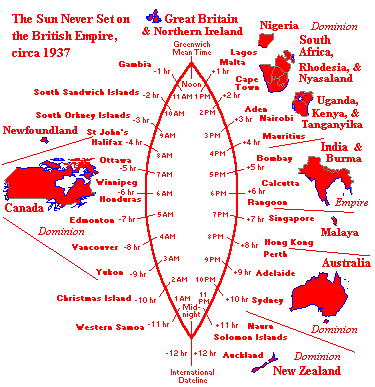 | |||
| George VI | 1936-1952 | Neville Chamberlain | 1937-1940 |
| Winston S. Churchill | 1940-1945, 1951-1955 | ||
| Clement R. Attlee | 1945-1950/ 1950-1951 | ||
| Partition of India, Independence of India & Pakistan, 1947 | |||
| Elizabeth II | 1952-present | Sir Anthony Eden | 1955-1957 |
| Harold Macmillan | 1957-1959/ 1959-1963 | ||
| Sir Alec Douglas-Hume | 1963-1964 | ||
| Harold Wilson | 1964-1970, 1974-1976 | ||
| Edward Heath | 1970-1974 | ||
| James Callaghan | 1976-1979 | ||
| Margaret Thatcher | 1979-1983/ 1983-1987/ 1987-1990 | ||
| John Major | 1990-1992/ 1992-1997 | ||
| Tony Blair | 1997-2001/ 2001-present | ||
Queen Victoria married Albert of the German House of Saxe-Coburg-Gotha. There was nothing awkward about this at the time, since Victoria herself was from the German House of Hanover, but it eventually became awkward when Britain and Germany went to war in 1914. As anti-German feeling rose, George V adopted the name "Windsor" for the Royal Family. The future Queen Elizabeth II married Prince Philip of Greece, who renounced his claims to the Greek Throne and adopted his mother's family name, "Mountbatten." The Mountbattens were another German family, the Battenbergs, that had also changed its name in Britain during World War I. Charles, the present Prince of Wales, would thus be the first King of the House of Mountbatten. Charles regarded the World War II hero, Lord Mountbatten of Burma, his great-uncle, as his "honorary grandfather." Queen Elizabeth has indicated her preference that it be styled the House of "Windsor-Mountbatten"; but what Charles calls it, when and if he becomes King, is presumably up to him.
By the 1970's, Britian was being called by some the "Sick Man of Europe," on
analogy to the 19th century Ottoman Empire (a bitter
irony, since British policy in the 19th century had succeeded in preventing the
Empire from being overthrown by Egypt or conquered by Russia). The main problem
was the "British Disease," namely labor unions which absolutely froze innovation
in industries and which perpetuated money losing government industries, like
coal, which had been nationalized by the Laborites after World War II. Britain
was turning into a stagnant Soviet kind of economy. Margaret Thatcher,
the "Iron Lady," came to office and completely turned this around, actually
breaking unions and privatizing state industries. What used to be the
industrial heartland of England, in the North, became a Rust Belt, and the South
became the center of growth, innovation, and Tory voting strength. Thatcher
became the longest serving Prime Minister of the 20th century, only to be
deposed through an internal Party coup. The work was left unfinished, with
welfare state white elephants, like the National Health Service, left untouched,
though even now British unemployment is far from the double digits familiar in
Euro-socialist France and Germany. The bland and supine John Major could live
off Thatcherite capital for another seven years, until well earned electoral
catastrophe in 1997. The Labor Party, which had been openly and insanely
pro-Soviet in the 1980's, has been transformed into a close copy of Bill Clinton's dissimulating,
Trojan Horse Democratic Party, whereby socialistic goals could be masked with
simple paternalism -- which means, appalling, that paternalism now appeals to
both American and British voters. Nevertheless, like Clinton, Blair has done a
creditable job of keeping the British economy in reasonable shape, poised
between booming Ireland and stagnant France. Despite brief furry over high
gasoline prices, which in Britain cannot be blamed on private "corporate greed,"
Blair was resoundingly reelected in 2001.
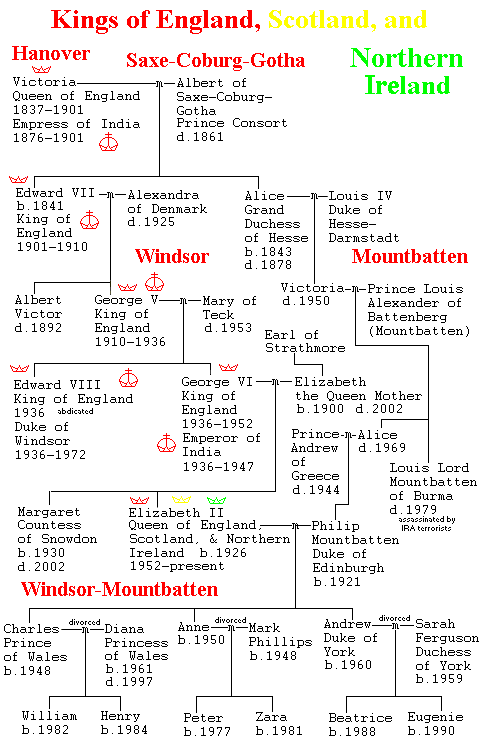
Bibliography and Suggested Reading
The Sun Never Set on the British Empire
British Coins before the Florin, Compared to French Coins of the Ancien Régime
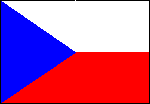 , Poland
, Poland 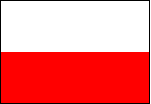 ,
and Hungary
,
and Hungary 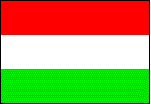 ,
845-1795
,
845-1795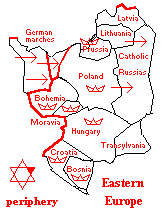 By the year 1000,
the Slavic kingdoms of Bohemia-Moravia, Poland, and Croatia and the Magyar
kingdom of Hungary, had all become sufficiently organized and Christianized to
enter European history. The earliest organization visible may be that of the
Czechs under Samo (c.623-658), who succeeded in defeating the Franks
(631). This state disintegrated with his death, however.
By the year 1000,
the Slavic kingdoms of Bohemia-Moravia, Poland, and Croatia and the Magyar
kingdom of Hungary, had all become sufficiently organized and Christianized to
enter European history. The earliest organization visible may be that of the
Czechs under Samo (c.623-658), who succeeded in defeating the Franks
(631). This state disintegrated with his death, however.
| Kings of Great Moravia | |
|---|---|
| Mojmir I | 830-846 |
| Rastislav | 846-870 |
| Sviatopluk | 870-894 |
| Mojmir II | 894-906 |
| Dukes & Kings of Croatia | |
|---|---|
| Viseslav | Duke, c.800-c.810 |
| Borna | c.810-821 |
| Vladislav | 821-c.835 |
| Mislav | c.835-c.845 |
| Trpimir I | c.845-864 |
| Zdeslav | 864, 876-879 |
| Domagoj | 864-876 |
| Iljko | 876 |
| Branimir | 879-892 |
| Mutimir | 892-910 |
| Tomislav I | 910-924 |
| King, 924-928 | |
| Trpimir II | 928-c.935 |
| Kresimir I | c.935-c.945 |
| Miroslav | c.945-c.949 |
| Kresimir II | c.945-c.969 |
| Drzislav | c.969-997 |
| Suronja | |
| Svetoslav | 997-1000 |
| Kresimir III | 997-1030 |
| Goislav | 997-1020 |
| Stephen | 1030-1058 |
| Kresimir IV | 1058-1074 |
| Slavic | 1074-1075 |
| Dimitar Zvonimir | 1075-1089 |
| Helena | 1088-1091 |
| Stephen II | 1089-1091 |
| Almos | 1091-1093 |
| Peter | 1093-1097 |
| to Hungary, 1097 | |
The first durable state and kingdom in the East is that of Croatia, which was part of the Carolingian empire, revolting against it in 818. This contact, however, and the convenient situation for commerce on the Adriatic, enabled Croatia to develop a bit faster than the hinterland; and when Tomislav I accepted a crown from the Pope in 924, he created the first permanent Kingdom in Eastern Europe. Croatia, however, was not fated to endure on its own. Internal divisions tempted the Hungarians, who conquered the Kingdom in 1091, leaving it under the local rulers until the failure of the dynastic line. Meanwhile, Venice had conquered Dalmatia (1000), but the Hungarians retrieved it (1095-1102), beginning a long historical tug-of-war between the two states. Hungary (1001), Poland (1025), and Bohemia (1086, 1156) followed Croatia in becoming permanent Kingdoms.
Early Poland contended with the Germans for the intermediate territories (Lusatia and even Bohemia) but later steadily lost ground to the German move to the East, and to Bohemia, though in recent time much of this territory was abruptly recovered thanks to Soviet dispensation at the end of World War II. Pagan holdouts Prussia and Latvia were conquered and converted by the Teutonic Knights. By the 14th century, the last pagan holdout in Europe, the Grand Duchy of Lithuania, finally converted and by a historic marriage joined its fate to Poland.
Poland, Hungary, and Bohemia form a natural unit as they often had ruling dynasties in common. Later, however, the intermarriage of these dynasties with those of Francia, and the Polish election of kings from Francia, delivered the kingdoms to external possession. The Hapsburgs ended up in permanent possession of Bohemia-Moravia and Hungary (until World War I), while Poland was surrounded and devoured by Prussia, Austria, and Russia. Bohemia, with a large German population, came to be considered part of Germany, and the King of Bohemia became an Elector of the Holy Roman Emperor. When Bohemia and Moravia then passed to the Hapsburgs, the King of Bohemia typically was also the actual Holy Roman Emperor. The Germans of Bohemia are now gone, since Hitler used them as a pretext to occupy Czechoslovakia in 1938, and they were expelled after World War II.
| Bans & Kings of Bosnia | |
|---|---|
| Boric | Ban (viceroy), 1154-1163 |
| to Romania, 1163-1180 | |
| Kulin | 1172-1204 |
| Stephen | 1204-1232 |
| Matthew Ninoslav | 1232-c.1253 |
| Prijezda I Kotromanic | 1254-1287 |
| Prijezda II | 1287-1290 |
| Stephen I | 1267-1302, d. 1313 |
| Mladen I Subic | 1302-1304 |
| Mladen II | 1304-1322 |
| Stephen II Kotromanic | 1322-1353 |
| Tvrtko I | 1353-1376 |
| King, 1376-1391 | |
| Stephen Dabisa | 1391-1395 |
| Helena the Crude | 1395-1398 |
| Stephen Ostoja | 1398-1404, 1409-1418 |
| Tvrtko II | 1404-1409, 1421-1443 |
| Stephen Ostojic | 1418-1421 |
| Stephen Thomas | 1443-1461 |
| Stephen Tomasevic | 1461-1463 |
| Ottoman conquest, 1463 | |
| Dukes or Princes of Transylvania, Hungarian Suzerainty | |
|---|---|
| Lorand Lepes | 1415-1438 |
| Lancu of Hunedoara | 1441-1456 |
| to Ottoman
Empire, 1526-1699 | |
| John Zapolya | 1526-1540 |
| King of Hungary, 1526-1540 | |
| John Sigismund | 1540-1571 |
| Gasnar Bekesy | 1571-1572 |
| Polish Occupation, 1572-1576 | |
| Christopher Bathory | 1576-1581 |
| Sigismund | 1581-1598 |
| Andrew | 1599-1600 |
| Michael the Brave | 1600-1601 |
| Moyses Szekely | 1602-1603 |
| Austrian
Occupation, 1602-1605 | |
| Stephen Bocskai | 1605-1606 |
| Sigismund Rakoczi | 1607-1608 |
| Gabriel Bathory | 1608-1613 |
| Gabriel Bethlen | 1613-1629 |
| Stephen Bethlen | 1630 |
| George Rakoczy I | 1630-1648 |
| George Rakoczy II | 1648-1660 |
| Achatius Bocskai | 1658-1660 |
| Johann Kemeny | 1661-1662 |
| Michael Apafi I | 1661-1690 |
| Emerich Tokoli | 1682-1699 |
| Michael Apafi II | 1690-1699 |
| to Austria-Hungary, 1699-1919 | |
| Francis Rakoczy | 1704-1711 |
| to România, 1919 | |
Transylvania ("beyond the forest"), although largely Romance speaking,
was historically part of Hungary. The history of the ethnic composition of the
region is still hotly disputed by Hungarian and
Romanian historians. Largely surrounded by mountains, the plateau of
Transylvania, Dacia to the Romans, was relatively isolated and protected
from the grassy lowlands around it, which were the avenues of incursion from the
Steppe. Although certainly
the name most commonly associated with Transylvania, one will search the list of
Princes in vain for (Count) Dracula, who was actually the much earlier Prince
Vlad of Wallachia. The
Ottoman conquest of Hungary in 1526 brought the area under Turkish control,
although it was then largely ruled through appointed Princes, as were Wallachia
and Moldavia. When the Turks were expelled in 1699 by the Hapsburgs,
Transylvania was then ruled again from Hungary, without the device of local
Princes. It passed to România after World War I
and, except for a part returned to Hungary by
Hitler, has remained there ever since.
The small map of Eastern Europe above also shows the "Catholic Russias,"
meaning parts of Belorussia and the Ukraine. They acquired that religious
character through long possession by Lithuania and union with Poland and were
recovered for Russia first by the Tsars and then again, after another period of
rule by Poland (1920-1939), by the Soviet Union (in the coordinated invasion and
partition of Poland by Hitler and Stalin). Those who have held to their
Catholicism have been troubled both under the Tsars and under the Communists.
| Grand Dukes of Lithuania | |
|---|---|
| Mindaugas | 1236-1263 |
| Treniota | 1263-1264 |
| Vaisvilkas | 1264-1267 |
| Svarnas | 1267-1270 |
| Traidenis | 1270-1281/2 |
| Pukuveras | c.1283-1294 |
| Viten / Vytenis |
1295-1316 |
| Gediminas | 1316-1331 |
| Ivan I of Moscow |
1331-1341 |
| Jaunutis | 1341/2-1345 |
| Olgierd / Algirdas |
1345-1377 |
| Jogaila / Jagiello |
1377-1434 |
| converts to Christianty; marries Jadwiga; becomes Wladyslaw V of Poland | |
| Vytautas / Witold the Great |
regent, 1392 Grand Duke 1401-1430 |
| Swidrygiello | 1430-1432 |
| Zygmunt | 1432-1440 |
| Duchy passes to Casimir IV | |
At left are the Grand Dukes of Lithuania. Mindaugas converted to Christianity and received a crown from the Pope, but after him the country reverted to paganism, the last country in Europe to practice pre-Christian religion. Although Lithuania resisted conversion for over a century, we unfortunately know very little about what its religion was like. Meanwhile it was expanding vigorously all the way into the Ukraine. The conversion of Jagiello to Christianity and his marriage to the Anjevian heiress of Poland, Jadwiga, produced a large powerful country and rounds off the Christianization of Europe. The defeat of the Teutonic Knights at Tannenberg in 1410 held the promise of a dominant position in Eastern Europe, but over time this promise slipped away.
My sources for some of the early material, especially Poland, show some conflicting information. Sorting out the Polish Kings was a bit of a compromise between Iwo Cyprian Pogonowski's Poland, A Historical Atlas [Dorset Press, New York, 1988, pp. 56-57] and Gene Gurney's Kingdoms of Europe [Crown Publishers, New York, 1982, pp. 521-522]. And I've kept coming across references to people who were elected briefly but not mentioned in those sources. I was able to fill some gaps in the line of the Dukes of Lithuania and some early Przemysls and Arpads from Bruce R. Gordon's Regnal Chronologies. The Kings of Croatia come from The Cambridge Medieval History, Volume II, c.700-c.900 [Rosmond McKitterick, editor, Cambridge, 1995, p.862] and from Gordon, as do the Kings of Bosnia. Now, however, I have a stupifying dense and complete source of information in the Erzählende genealogische Stammtafeln zur europäischen Geschichte. I have been able to make some additions and corrections for Bohemia from Volume I, Part 1, Deutsche Kaiser-, Königs-, Herzogs- und Grafenhäuser I [Andreas Thiele, Third Edition, R. G. Fischer Verlag, 1997], and for Hungary from Volume II, Part 2, Europäiche Kaiser-, Königs- und Fürstenhäuser II Nord-, Ost- und Südeuropa [Andreas Thiele, R. G. Fischer Verlag, Part 2, Second Edition, 1997]. I hope to make further additions and corrections as I am able to study this source.
The background colors in the table below (not above, except for Lithuania)
are coded for dynasties rather than countries, since the overlapping of rulers
is one of the conspicuous features of the histories of Bohemia, Hungary, and
Poland. In the genealogical charts, however, red is used for Poland, green for
Hungary, and blue for Bohemia. With each of the these, the word for "duke" may
have ambiguities similar to what we find with the Russian word
knyaz. This is certainly the case with Lithuanian, where
kunigaikshtis can be translated either "prince" or "duke," and apparently
with voivode in Hungarian. In Poland and Hungary, conversion to
Christianty brought with it a royal crown from the Pope. Bohemia, as it became
part of the East Frankish
Kingdom, qualified less obviously for its own status as a Kingdom, which
came later. With each of these, however, the word for "king" is noteworthy. In
Czech it is král, in Polish król, and in Hungarian király.
For comparison, the same word in Croatian is kralj, in Slovakian
král', in Russian koról, and in Lithuanian karalius. Just
as the Latin name Caesar gives us the word for "emperor" in many of these
languages (and in German), here it looks like Carolus Magnus, Charlemagne, has given
us the word for "king." Since the Slavic languages had not diverged very much in
the 9th century, the title could have been borrowed into all of them virtually
simultaneously, and then into Hungarian (which isn't Slavic, or even
Indo-European) when the Magyars arrived. Note that "Wenceslas" and "Ladislas"
are the Latin versions of, respectively, Václav in Czech and
László in Hungarian.
| Duke & Kings of Bohemia & Moravia |
Dukes & Kings of Hungary | Dukes & Kings of Poland | |||
|---|---|---|---|---|---|
| Przemysls | |||||
| Borivoi Przemysl |
Duke, 845-895 |
Arpads | |||
| Spytihnev I | 895-907 | Árpád | Duke, Khân, or Prince, c.896-907 | ||
| Vratislav | 907-921 | Zoltan | 907-946 | ||
| St. Wenceslas | 921-929 | Fausz/Val | 946-952 | ||
| Boleslav I | 929-967 | Tacsony | 952-972 | Piasts | |
| Boleslav II | 967-999 | Geza | 972-997 | Mieszko I Piast | Duke, 960-992 |
| Boleslav III | 999-1003, 1004-1012, d.1037 |
St. Stephen I | 997-1001 | Boleslaw I the Brave |
992-1025; King, 1025 |
| Udalrich | 1012-1032, d.1034 |
King, 1001-1038 |
Duke of Bohemia, 1003-1004 | ||
| Jaromir | 1032-1034, d.1038 |
||||
| Brestislav I | 1034-1055 | Peter Urseolo | 1038-1041, 1044-1046 |
Mieszko II | 1025-1034 |
| Samuel Aba | 1041-1044, d.1046 | ||||
| Spytihnev II | 1055-1061 | Andrew I | 1047-1061 | [interregnum] | 1034-1038 |
| Bela I | 1061-1063 | Kazimierz I / Casimir I the Restorer |
1038-1058 | ||
| Vratislav | 1061-1086; King, 1086-1092 |
Solomon | 1063-1074 | Boleslaw II the Bold |
1058-1079 |
| Geza I | 1074-1077 | ||||
| St. Ladislas I | 1077-1095 | Wladyslaw I Herman |
1079-1102 | ||
| Brestislav II | Duke, 1092-1110 |
Coloman (Kalman) |
1095-1114 | Boleslaw III Wrywouth |
1102-1138 |
| Vladislav I | 1111-1125 | Stephen II | 1114-1131 | ||
| Sobeslav I | 1125-1140 | Bela II | 1131-1141 | Wladyslaw II the Exile |
1138-1146 |
| Geza II | 1141-1162 | Boleslaw IV the Curly |
1146-1173 | ||
| Vladislav II | 1140-1156; King, 1156-1173 |
Ladislas II | 1162-1163 | ||
| Stephen III | 1162-1172 | ||||
| Stephen IV | 1163-1165 | ||||
| [ten rulers] | 1173-1197 | Bela III | 1172-1196 | Mieszko III the Old |
1173-1177 1194-1202 |
| Ottokar I | 1197-1230 | Emeric | 1196-1204 | Kazimierz II the Just |
1177-1194 |
| Ladislas III | 1204-1205 | Leszek I the White |
1202-1227 | ||
| Wenceslas I | 1230-1253 | Andrew II | 1205-1235 | Wladyslaw III Spindleskanks |
1228-1231 |
| Bela IV | 1235-1270 | Henryk I the Bearded of Silesia |
1231-1238 | ||
| Henryk II the Pious |
1238-1241 | ||||
| Konrad I Mazowiecki |
1241-1243 | ||||
| Ottokar II the Great |
1253-1278 | Boleslaw V the Chaste |
1243-1279 | ||
| Stephen V | 1270-1272 | Leszek II the Black |
1279-1288 | ||
| Henryk IV Probus |
1288-1290 | ||||
| Ladislas IV | 1272-1290 | Przemyslaw | 1290-1296 | ||
| 1278-1305 | Václav II / Wenceslas II |
Andrew III last Arpad |
1290-1301 | Wenceslas II of Bohemia |
1300-1305 |
| 1301-1305 | |||||
| Wenceslas III last Przemysl |
1305-1306 | Otto (III) of Bavaria |
1305-1307 | Waclaw III / Wenceslas III of Bohemia |
1305-1306 |
| Rudolf of Hapsburg | 1306-1307 | ||||
| Henry of Carinthia |
1307-1310 | Charles I of Anjou |
1308-1342 | Wladyslaw IV the Short |
1306-1333 |
| John of Luxemburg | 1310-1346 | Kasimierz III / Casimir III the Great -- last Piast |
1333-1370 | ||
| Charles I Emperor Charles IV |
1347-1378 | 1342-1382 | Louis I the Great Ludwik |
1370-1382 | |
| Wenceslas IV | 1378-1419 | Mary of Anjou; marries Emperor Sigismund |
1382-1385 1386-1395 |
[interregnum] | 1382-1383 |
| Charles II of Naples |
1385-1386 | Jadwiga of Anjou marries Jagiello |
1383-1399 | ||
| 1419-1437 | Emperor Sigismund | 1387-1437 | Wladyslaw V Jagiello Grand Duke of Lithuania |
1386-1434 | |
| 1437-1439 | Albert of Austria | 1437-1439 | Teutonic
Knights defeated at Tannenberg, 1410 | ||
| 1439-1457 | 1440-1444 | Vladislav Jagiello/Wladyslav VI |
1434-1444 | ||
| Ladislas I Posthumus Ladislas V of Hungary |
1444-1457 | [interregnum] | 1444-1447 | ||
| George Podiebrad | 1459-1471 | Matthias Corvinus | 1458-1490 | Kazimierz IV / Casimir IV |
Grand Duke of Lithuania, 1440 |
| 1446-1492 | |||||
| 1471-1516 | Ladislas II/ Vladimir Jagiello Ladislas VI of Hungary |
1490-1516 | John I Albert | 1492-1501 | |
| 1516-1526 | Louis/ Louis II of Hungary-- killed by the Süleymân I at the Battle of Mohács |
1516-1526 | Alexander | 1501-1506 | |
| 1526-1564 | Ferdinand of Austria | John Zapolya, Duke of Transylvania |
1526-1540 | Sigismund I | 1506-1548 |
| 1527-1564 | Sigismund II Augustus | 1548-1572 | |||
| Bohemia, Moravia, & Hungary
continue with the Hapsburgs, 1564-1918 |
Union of Poland & Lithuania, 1569 | ||||

Hungary is named after the Huns, who camped on the Hungarian plain in the 5th century. But the modern Hungarians are not Huns, they are Magyars, another steppe people speaking a Uralic language ultimately related to Finnish, Estonian, and other languages in Siberia. The Magyars arrived after being defeated by the Patzinaks in 892. They were encouraged by the Emperor Arnulf to attack Great Moravia, which they succeeded in overthrowing by 906. Unfortunately for the Franks, the Magyars then extended their attacks into Western Europe, adding to the misery of the "Second Dark Age" of that era, while the Vikings and Arabs raided from north and south. "Prince" is probably not the right title for the earliest leaders (I don't know if they used the Turko-Bulgarian khan), like the eponymous Árpád, but it became more appropriate after the Magyars were tamed by defeats at the hands of King Henry I at Riade in 933 and then especially by Otto I at Lechfield in 955. Soon Christianity and a royal crown from the Pope were brought to Hungary by St. Stephen, producing one of the great constituent Kingdoms of Francia. St. Stephen's sister even married a Doge of Venice, whose son then briefly succeeded Stephen. Some of the dates in the diagram are different from those in the table above. This reflects conflicts in the sources. The diagram also gives more of the Hungarian renderings of the names than in the table above. The origin of the Bavarian, Bohemian, and Anjevian claims to the Hungarian throne are evident in the marriages shown.
The genealogical diagram below begins well into the Premysl and Piast
dynasties. With the Arpads given at left, the first King of Hungary shown below
is Wenceslas II of Bohemia. The succession of the Piasts is bewildering, as the
Throne jumps from brother to brother and then cousin to cousin. Then the
Premsyls get involved, and then the houses of Luxemburg and Anjou. Later, as the
Premysl and Piast male lines end, we get the entry of the Hapsburgs and
Jagiellans (from Lithuania). The Hapsburgs come and go and then come back, by
the end to permanently acquire Bohemia and Hungary. Poland, with a sprinkling of
in-laws or unrelated Kings, passes to the Vasa dynasty of Sweden. With the end
of the Vasa Kings, the elective principle reigns supreme in Poland. The
Hapsburgs get their big break when the Jagiellan Louis II of Hungry is killed by
the Turks in the Battle of Mohács in 1526 and his brother-in-law, Ferdinand of
Austria, future Emperor and brother of the Emperor Charles V, pressed his
claims to the kingdoms.
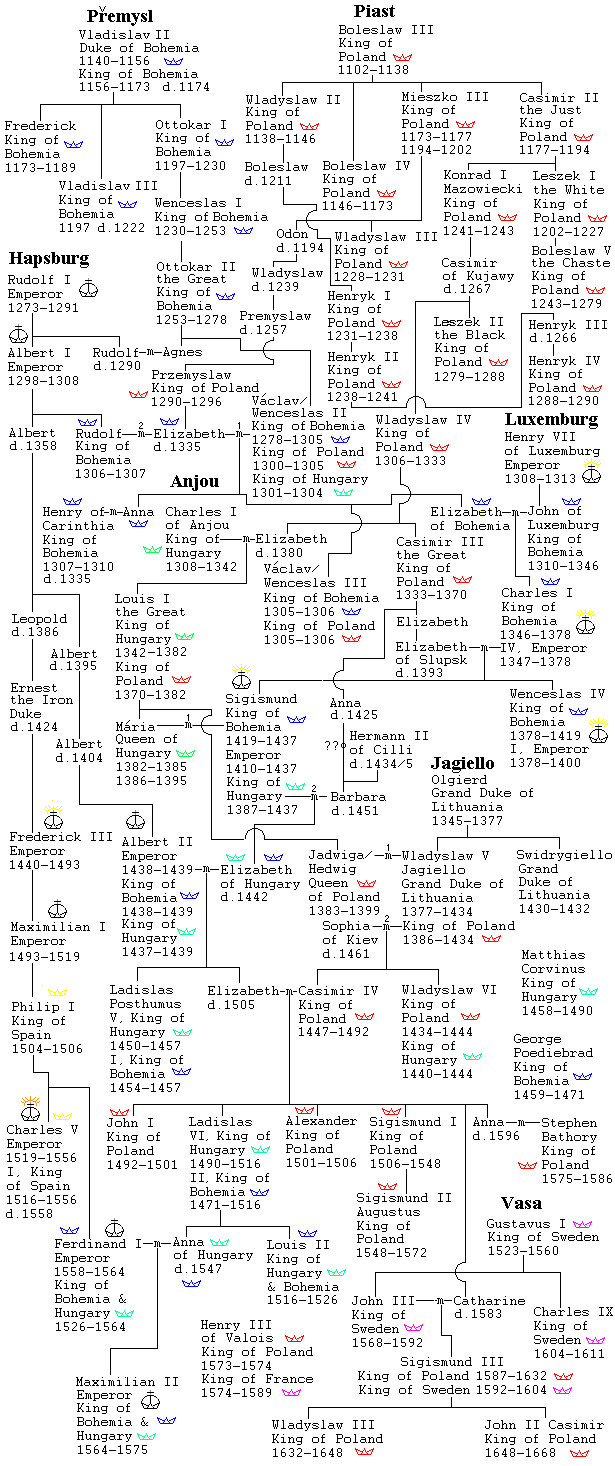
| Kings of Poland | |
|---|---|
| Henry of Valois | 1573-1574 |
| King of France 1574-1589 | |
| Stephen Bathory | 1575-1586 |
| Sigismund III Vasa | 1587-1632 |
| Wladyslaw VII | 1632-1648 |
| Tsar of Russia, 1610-1612 | |
| John II Casimir | 1648-1668 |
| Michael Wisniowiecki | 1669-1673 |
| John III Sobieski | 1674-1696 |
| Augustus II the Strong (I of Saxony) |
1697-1706 1709-1733 |
| Saxony, 1694-1733 | |
| Stanislas Lesczynski | 1704-1709 1733 |
| Lorraine, 1737-1766 | |
| War of the Polish Succession, 1733-1735 | |
| Augustus III (II of Saxony) |
1733-1763 |
| Saxony 1733-1763 | |
| Stanislas Poniastowski |
1764-1795 |
| Poland partitioned between Prussia, Austria, & Russia: 1772, 1793, & 1795 | |
| Frederick Augustus (III/I of Saxony) |
Grand Duke of Warsaw, 1807-1815 |
| Saxony 1763-1827 | |
The end of the Jagiellan dynasty reveals the elective principle of the Polish Throne. After the brief tenure of the Vasa Kings, Polish candidates alternate with foreigners, and the election becomes a matter of European power politics, a Great Power tug-of-war between France and Russia, especially evident in the brief and farcical War of the Polish Succession. Real Polish interests stand little chance of survival in such a situation. Eventually, foreign control of the elections and candidates suggests direct foreign control of the country, and Poland and Lithuania vanish in three partitions.
.gif) At right are the stages in the partition of Poland, by which
Prussia, Russian, and Austria erased Poland and Lithuania from the map of
Europe. The last two stages seem to have been in part defensive measures against
the French Revolution, to whose enthusiasms Poland, with a weak monarchy, was
seen as susceptible. Napoleon's later revival of a Polish state confirmed the
role of Poland as a subversive force. At the Congress of Vienna in 1815, Poland
was erased again. Russia ended up with most of the Prussian and Austrian shares
of 1795, and some of Prussia's 1793 slice. Poland and Lithuania were not
independent again until after World War I, only to have Poland partitioned again
between Germany and the Soviet Union in 1939, with Lithuania absorbed by the
latter in 1940. Stalin kept his part of Poland after World War II, compensating
a communist Poland with large pieces of Germany. Lithuania only regained its
independence with the fall of the Soviet Union in 1991.
At right are the stages in the partition of Poland, by which
Prussia, Russian, and Austria erased Poland and Lithuania from the map of
Europe. The last two stages seem to have been in part defensive measures against
the French Revolution, to whose enthusiasms Poland, with a weak monarchy, was
seen as susceptible. Napoleon's later revival of a Polish state confirmed the
role of Poland as a subversive force. At the Congress of Vienna in 1815, Poland
was erased again. Russia ended up with most of the Prussian and Austrian shares
of 1795, and some of Prussia's 1793 slice. Poland and Lithuania were not
independent again until after World War I, only to have Poland partitioned again
between Germany and the Soviet Union in 1939, with Lithuania absorbed by the
latter in 1940. Stalin kept his part of Poland after World War II, compensating
a communist Poland with large pieces of Germany. Lithuania only regained its
independence with the fall of the Soviet Union in 1991.
While the election of the Polish Kings is sometimes celebrated as creating a
Republic, this was not only merely a government of self-interested nobility, the
only electors, but it gives us the most sobering paradigm in all of history for
the disaster that is invited in by a divided and hopelessly impotent government.
Poland became a plaything, a joke, and then, after the German occupation in
World War II, and place of incomprehensible crime and horror. The Jews of
Poland, some 10% of the population of Poland in 1939, brought in by the
Mediaeval Kings to create a commercial class, and then resented by Polish
peasants for their consequent wealth and status, were all but exterminated by
the Germans. Forty years of Soviet rule then served to suppress such commercial
instincts as existed elsewhere. Now, post-communist Poles, while hating
Communism (not to mention the Russians), still know little better than to elect
ex-Communists to the government. After World War I, Bohemia (and Moravia) became
part of Czechoslovakia with the hitherto Slovak part of Hungary.
| Czechoslovakia | Hungary | Poland | |||||
|---|---|---|---|---|---|---|---|
| Thomas Garrigue Masaryk | 1918-1935 | Miháaly Count Károlyi | 1919 | Jozef Pilsudski | 1918-1922 | ||
| Sándor Garbai | 1919 | Gabriel Narutowicz | 1922 | ||||
| Eduard Benésh | 1935-1938 | Miklos Horthy | 1920- 1944 | Stanislaw Wojchiechowski | 1922-1926 | ||
| Ignacy Moscicki | 1926-1939 | ||||||
| German Occupation, 1938-1945 | German Occupation, 1939-1945 | ||||||
| Emil Hácha | Bohemia- Moravia, 1938- 1945 |
Jozef Tiso | Slovakia 1939- 1945 |
Ferenc Szálasi | 1944- 1945 | ||
| Eduard Benésh | 1945-1948 | Soviet Occupation, 1945-1991 | |||||
| Zoltán Tildy | 1946- 1948 | Boleslaw Bierut | 1947-1952 | ||||
| Klement Gottwald | 1948-1953 | Árpád Szakasits | 1948- 1950 | ||||
| Sándor Ronai | 1950- 1952 | ||||||
| Antonin Zápotocký | 1953-1957 | István Dobi | 1952- 1967 | Aleksander Zawadzki | 1952-1964 | ||
| Antonin Nóvotný | 1957-1968 | Edward Ochab | 1964-1968 | ||||
| Ludvig Svoboda | 1968-1975 | Pál Kosonczi | 1967- 1987 | Marian Spychalski | 1968-1970 | ||
| Soviet Occupation, 1968-1991 | Jozef Cyrankiewicz | 1970-1972 | |||||
| Gustav Husák | 1975-1989 | Karoly Nemeth | 1987- 1988 | Henrik Jablonski | 1972-1985 | ||
| Bruno Straub | 1988- 1990 | Wojciech Jaruzelski | 1985-1990 | ||||
| Václav Havel | Czech Republic, 1989- present |
Michael Kovác | Slovakia 1993- 1998 |
Árpád Goncz | 1990- 2000 | Lech Walesa | 1990-1995 |
| Rudolf Schuster | 1999- Present | Ferenc Mádl | 2000- present | Aleksander Kwaniewski | 1995- present | ||
The most prosperous country in Eastern Europe, Czechoslovakia was first
dismembered and terrorized by Nazi Germany and then fell to Communism through an
internal coup (with the probable murder, but official suicide, of Eduard
Benésh, the pre-War President), the only country in Eastern Europe not to
become Communist merely through Soviet occupation. 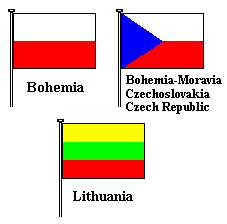 Occupation it became after
the "Prague Spring" of 1968, when Alexander Dubcek tried to reform the
regime and create "Communism with a human face." This oxymoron was crushed by
Soviet tanks, and freedom again slept until the miraculous year of 1989, when
the regime abruptly fell.
Occupation it became after
the "Prague Spring" of 1968, when Alexander Dubcek tried to reform the
regime and create "Communism with a human face." This oxymoron was crushed by
Soviet tanks, and freedom again slept until the miraculous year of 1989, when
the regime abruptly fell.
| Lithuania | |
|---|---|
| Antanas Smetona | 1919-1922, 1926-1940 |
| Alexandras Stulginskis |
1922-1926 |
| Kazys Grinius | 1926 |
| Soviet Occupation, 1940-1941, 1944-1991 | |
| German Occupation, 1941-1944 | |
| Vytautas Landsbergis |
1991-1992 |
| Algirdas Brzauskas | 1992-1998 |
| Valdas Adamkus | 1998-present |
| Croatia | |
|---|---|
| Yugoslavia, 1918-1941, 1945-1991 | |
| German Occupation, 1941-1945 | |
| Tomislav (II, Aimone of Spoleto?) |
King, 1941-1943 |
| Ante Pavelic | 1943-1945 |
| Franjo Tudjman | 1991-1999 |
| Stjepan Mesic | 2000-present |
| Bosnia Herzegovina | |
|---|---|
| Yugoslavia, 1918-1941, 1945-1992 | |
| German Occupation, 1941-1945 | |
| Alija Izetbegovic | 1992-2001 |
| Ziviko Radisic | Serbian, 1998-2001 |
| Ante Jelvic | Croatian, 1998-2001 |
| Bozidor Matic | 2001-present |
Heads of State for the post-World War I nations are taken from the
Regentenlisten und Stammtafeln zur Geschischte Europas by Michael F.
Feldkamp [Philpp Reclam, Stuttgart, 2002].
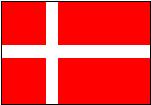 Denmark,
Denmark, 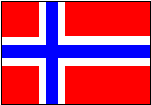 Norway, and
Norway, and 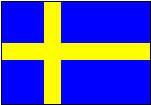 Sweden,
588 AD-Present
Sweden,
588 AD-Present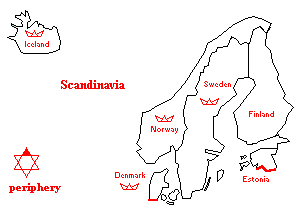 Scandinavia forms a
natural unit in the Periphery of Francia, not the least because Denmark, Norway,
& Sweden, whose early history is scrambled together, were also eventually
united, by the Union of Kalmar, in 1397. Otherwise, converting to Christianity
at about the same time as the Eastern European peoples, the Scandinavian
kingdoms had relatively little influence on European history in general after
the great period of pre-Christian Norse and Varangian raiding and conquest in
West and East. This influence was considerable enough, even just noting the
permanent foundations of Normandy, Norman Sicily and Naples, Norman
England, and
Varangian Russia. Gustavus
Adolphus entering the Thirty Years War was then probably the last decisive
Scandinavian intervention in European history.
Scandinavia forms a
natural unit in the Periphery of Francia, not the least because Denmark, Norway,
& Sweden, whose early history is scrambled together, were also eventually
united, by the Union of Kalmar, in 1397. Otherwise, converting to Christianity
at about the same time as the Eastern European peoples, the Scandinavian
kingdoms had relatively little influence on European history in general after
the great period of pre-Christian Norse and Varangian raiding and conquest in
West and East. This influence was considerable enough, even just noting the
permanent foundations of Normandy, Norman Sicily and Naples, Norman
England, and
Varangian Russia. Gustavus
Adolphus entering the Thirty Years War was then probably the last decisive
Scandinavian intervention in European history.
The Flags the Scandinavian countries, as well as those of some dependencies,
are based on the venerable, 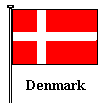 distinctively asymmetrical white cross on red of the
Dannebrog, which is supposed to have been adopted by King Valdemar II,
the Victorious, on 15 June 1219, establishing the earliest national flag in
continuous use since.
distinctively asymmetrical white cross on red of the
Dannebrog, which is supposed to have been adopted by King Valdemar II,
the Victorious, on 15 June 1219, establishing the earliest national flag in
continuous use since. 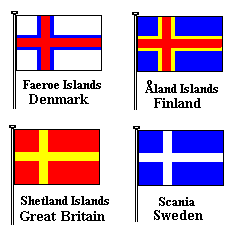 However, there is no real certainty that the flag was used before
the reign of Valdemar III (1340-1375).
However, there is no real certainty that the flag was used before
the reign of Valdemar III (1340-1375).
Here the background colors represent countries and combinations of countries. Denmark and Norway together appear as yellow; Norway and Sweden as blue; and all three together as white. These kingdoms pose a particular problem in listing the kings and giving the genealogy, since the historical rulers shade over gradually into the legendary, and then into the mythic, and it is very difficult to tell what kind of ground one is on. The table here begins with legendary rulers who are more or less historical, which means that they probably existed, even while dating them and identifying genuine events of their reigns involves considerable guesswork and uncertainty. Genealogy for the kings in the first table below, and for earlier legendary and mythic kings, is given separately at Legendary and Early Kings of Scandinavia. When that link is used, a new browser window will open for the page. If the window is reduced in size and positioned conveniently, the diagrams can be compared with the table in this window.
The picture here is a compromise between several sources. The best discussion of the difficulties and uncertainties is in the Royal Families of Medieval Scandinavia, Flanders, and Kiev by Rupert Alen and Anna Marie Dahlquist [Kings River Publications, Kingsburg, California, 1997]. While the title of this book mentions Flanders and Kiev, it deals with them from the perspective of intermarriages with Norwegan, Swedish, and Danish houses. Additonal information, especially on Denmark, Norway, and the early legendary and mythic material, is from The Mammoth Book of British Kings and Queens by Mike Ashley [Carroll & Graf Publishers, Inc., New York, 1998, 1999]. These two books have been compared with the large genealogical chart, Kings & Queens of Europe, compiled by Anne Tauté [University of North Carolina Press, 1989], and with Kingdoms of Europe, by Gene Gurney [Crown Publishers, New York, 1982]. There is considerable disagreement between the sources, even for historical kings, not just on dates (which can be infuriatingly different) but even on the succession and the occurrence of various rulers. Priority is given to the sources as listed, but even Alen and Dahlquist are not always consistent in their own presentation -- e.g. they have one chart showing the Sweden King Inge II living and reigning until 1130, while otherwise placing Magnus Nielsson from Inge's death in 1125 to 1130. On the other hand, Tauté also has Inge ruling until 1130 and doesn't show Magnus at all. And this is a confusion about rulers well within the historical period. Early in the chart it will be noted that Ragnar Lodbrok is listed both for Denmark and for Sweden, but at somewhat different periods -- and neither set of dates works if Ragnar is the Viking chief who sacked Paris in 845 and treated with Charles the Bald. This is a good indication of the uncertainties and mismatches that can occur in the early chronology. That Erik I of Sweden occurs after Erik II is also a good clue. All the Swedish Eriks are, nevertheless, accounted for (with Erik the Victorious as Erik VI, not always the number he is given). What is not accounted for are Swedish Kings Charles (Karl) I-VI, who all appear to be mythic. The numbers really should be redone, but it is too late for that -- the present King of Sweden is Charles XVI. Sometimes earlier Swedish Knuts are numbered, but not here -- Knut I (1167-1196) is the first.
| Kings of Denmark | Kings of Norway | Kings of Sweden | |||
|---|---|---|---|---|---|
| Ivar Vidfamne | 588-647 |
|
565-623 | ||
|
| |||||
| Harald I Hildetand | 647-735, or d.c.750 | Olaf the Tree-hewer | 680-710 | Harald Hildetand | 647-735, or d.c.750 |
| Sigurd Ring | 735-750, or c.770-812 | ||||
| Randver | c.750 | Halfdan I | 710-750 | Ragnar Lodbrok | 860-865, or 750-794 |
| Eystein I | 750-780 | Eystein Beli | 750 or 860-? | ||
| Sigurd I Ring | 735-750, or c.770-812 | Björn Järnsida | 794-804, or c.856 | ||
| Horik I | 850-854 | Halfdan II Whitelegs | 780-800 | Erik II | 804-808, or d.c.870 |
| Horik II | 854-? | Gudrod the Magnificent | 800-810 | Erik III | 808-820 |
| Ragnar Lobrok | c.860-865 | Olaf Geirstade | 810-840 | Edmund I | 820-859 |
| Sigurd II Snogoje | 865-873 | Halfdan III the Black | 840-863 | Erik I | d.c.870 |
| Hardeknut Canute I |
873-884 | Civil War, 863-885 | Björn | 870-920 | |
| Frodo | 884-885 | Harald I Fairhair |
885-933 | Olaf I Ring | 920-930 |
| Harald II Parcus | 885-899 | Eric I Bloodaxe |
933-934 | Eric IV Väderhatt | ? |
| Gorm the Old |
c.900-950 | Haakon I the Good |
934-963 | Erik V | 930-950 |
| Harald III Bluetooth |
c.950-986 | First Christian King | Edmund II | 950-965 | |
| First Christian King | Harald II Graypelt |
963-977 | Olaf II | 965-970 | |
| Sweyn I Forkbeard |
986-1014 | Haakon | Jarl of Lade, 977-995 |
Eric VI the Victorious | 970-995 |
| Olaf I Tryggvason | 995-1000 | ||||
| Eric | Jarl of Lade, 1000-1015 |
Olaf III Skötkonung | 995-1022 | ||
| Harald IV | 1014-1018 | St. Olaf II Haraldson | 1015-1028, d.1030 | ||
| 1018-1035 | Canute II the Great | King of England 1016-1035 | |||
| 1028-1035 | First Christian King | ||||
| Hardecanute, Canute III |
1035-1042 | Magnus I the Good |
1035-1047 | Anund Jakob Kolbrenner | 1022-1050 |
| King of England, 1040-1042 |
Edmund III Slemme | 1050-1060 | |||
| 1042-1047 | Stenkil | 1060-1066 | |||
| Sweyn II | 1047-1074 | Harald III Hardrade |
1047-1066 | Erik VII & Erik VIII |
1066-1067 |
| Magnus II | 1066-1069 | ||||
| Harold V Hen | 1074-1080 | Olaf III the Peaceful |
1066-1093 | Inge I the Elder |
1066-1080, 1083-1110 |
| Halsten | 1066-1070 | ||||
| Canute IV the Holy |
1080-1086 | Magnus III the Barefoot |
1093-1103 | Blot-Sven | 1180-1183 |
| Olaf IV Magnusson | 1103-1115 | Filip Halstensson |
1110-1118 | ||
| Olaf IV the Hungry |
1085-1095 | Eystein II | 1103-1122 | Inge II the Younger |
1118-1125 |
| Eric I the Evergood |
1095-1103 | Sigurd I the Crusader |
1103-1130 | ||
| Niels the Elder |
1103-1134 | Magnus IV the Blinded |
1130-1135, d.1139 |
Magnus Nielsson |
1125-1130 |
| Eric II | 1134-1137 | Harald IV Gillechrist | 1130-1136 | Sverker I the Elder |
1130-1156 |
| Eric III | 1137-1146 | Inge I | 1136-1161 | St. Eric IX | 1156-1160 |
| Sweyn III | 1146-1157 | Sigurd II | 1136-1155 | ||
| Canute V Magnussen |
1147-1157 | Eystein III | 1142-1157 | Charles VII | 1161-1167 |
| Valdemar I the Great |
1157-1182 | Haakon II | 1161-1162 | Knut I | 1167-1196 |
| Canute VI the Pious |
1182-1202 | Magnus V | 1163-1184 | Sverker II the Younger |
1196-1208, d.1210 |
| Valdemar II the Victorious |
1202-1241 | Sverre | 1184-1202 | Eric X | 1208-1216 |
| Eric IV | 1241-1250 | Haakon III | 1202-1204 | John I | 1216-1222 |
| Abel | 1250-1252 | Inge II Baardson |
1204-1217 | Eric XI | 1222-1229 1234-1250 |
| Christopher I | 1252-1259 | Haakon IV the Old | 1217-1263 | Knut II the Long | 1229-1234 |
It has been noted that genealogical diagrams for the table above are given elsewhere. Genealogies for
the following kings are given after their respective tables below. 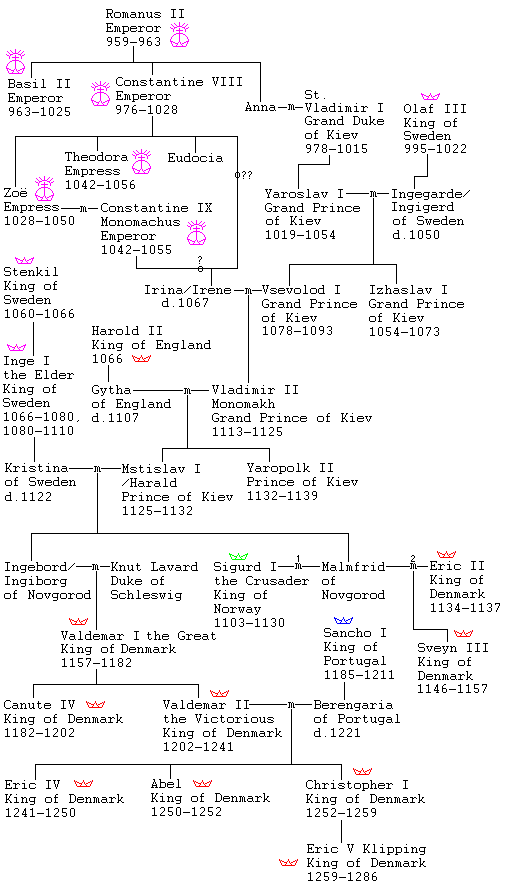 At right is a diagram for
descent and marriages of some of the kings above that involve Emperors of Romania (Byzantium) and
Grand Dukes or Princes of Kiev. This avenue of Romanian descent into subsequent
European royalty and nobility is the best authenticated, despite the remaining
uncertainty about the parentage of Irene. Otherwise, much less certain is the
Romanian descent of the Counts of Savoy.
At right is a diagram for
descent and marriages of some of the kings above that involve Emperors of Romania (Byzantium) and
Grand Dukes or Princes of Kiev. This avenue of Romanian descent into subsequent
European royalty and nobility is the best authenticated, despite the remaining
uncertainty about the parentage of Irene. Otherwise, much less certain is the
Romanian descent of the Counts of Savoy.
Noteworthy is also the connection to King Harold II of England, the Saxon
King who was killed at the battle of Hastings in 1066, as William the Conqueror
invaded England. While Harold did not have descendants in Britain directly, his
descendants through Kiev and Denmark ultimately lead to the marriage of Margaret
of Oldenburg to King James III of Scotland, from whom all subsequent Scottish
and then British monarchs are descended.
| Kings of Denmark | Kings of Norway | Kings of Sweden | |||
|---|---|---|---|---|---|
| Eric V | 1259-1286 | Magnus VI | 1263-1281 | Valdemar | 1250-1275 |
| Eric VI | 1286-1319 | Eric II | 1281-1299 | Magnus I | 1275-1290 |
| Haakon V | 1299-1320 | Berger | 1290-1320 | ||
| Christopher II | 1320-1332 | Magnus (VII of Norway, II of Sweden) | 1320-1365 | ||
| Haakon VI | 1343-1380 | Eric XII | 1356-1359 | ||
| Valdemar III | 1340-1375 | Albert | 1365-1388 | ||
| Olaf V (IV of Norway) | 1376-1387 | Duke of Mecklenburg, 1379-1412 | |||
| Union of Denmark & Norway, 1380 | |||||
|
|
1387-1412 | ||||
| Union of Kalmar -- Denmark, Norway, & Sweden, 1397 | |||||
|
|
1412-1439 | ||||
|
|
1439-1448 | ||||
|
|
Charles VIII | 1448-1457 1464-1465 1467-1470 | |||
| 1448-1481 | |||||
|
|
1481-1513 | ||||

| Denmark | Norway | Sweden | |||
|---|---|---|---|---|---|
|
|
1513-1523 | ||||
| Frederick I | 1523-1533 | Gustavus I Vasa | 1523-1560 | ||
| Christian III | 1534-1558 | Eric XIV | 1560-1568 | ||
| Frederick II | 1558-1588 | John III | 1568-1592 | ||
| Christian IV | 1588-1648 | Sigismund | 1592-1604 | ||
| Charles IX | 1604-1611 | ||||
| Gustavus II Adolphus | 1611-1632 | ||||
| Christina | 1632-1654 d.1689 | ||||
| Frederick III | 1648-1670 | Charles X | 1654-1660 | ||
| Christian V | 1670-1699 | Charles XI | 1660-1697 | ||
| Frederick IV | 1699-1730 | Charles XII "Madman of the North" | 1697-1718 | ||
| Queen Ulrika | 1718-1720 | ||||
| Christian VI | 1730-1746 | Frederick | 1720-1751 | ||
| Landgrave of Hesse, 1730-1751 | |||||
| Frederick V | 1746-1766 | Adolphus Frederick | 1751-1771 | ||
| Christian VII | 1766-1808 | Gustavus III | 1771-1792 | ||
| Gustavus IV Adolphus | 1792-1809 | ||||
| Frederick VI | 1808-1839 | Charles XIII | 1809-1818 | ||
| Christian VIII | 1839-1848 | Norway & Sweden, 1814 | |||
| Charles XIV Bernadotte |
1818-1844 | ||||
| Oscar I | 1844-1859 | ||||
| Frederick VII | 1848-1863 | Charles XV | 1859-1872 | ||
| Christian IX | 1863-1906 | Oscar II | 1872-1907 | ||
| Frederick VIII | 1906-1912 | Haakon VII | 1905-1957 | Gustavus V | 1907-1950 |
| Christian X | 1912-1947 | ||||
| Frederick IX | 1947-1972 | Olaf V | 1957-1991 | Gustav VI Adolph | 1950-1973 |
| Queen Margaret II | 1972-present | Harald V | 1991-present | Karl / Charles XVI Gustaf |
1973-present |
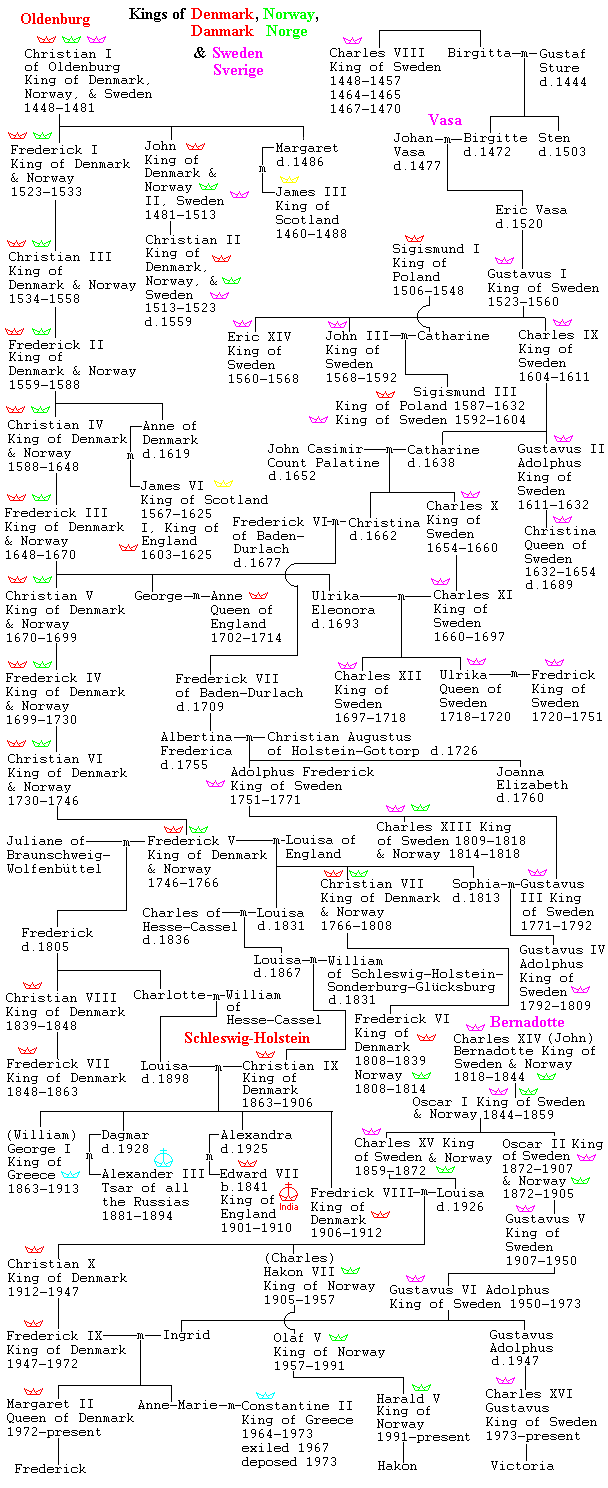
The Scandinavian countries are not well know for having
colonial possessions. At the height of its power, Sweden was preoccupied with
acquisitions in the Baltic area, like Finland, Estonia, Latvia, and Pomerania.
There was one distant colony of Sweden, however, in the future American State of
Delaware, called "New Sweden." 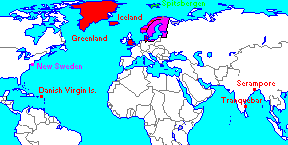 The first Swedish settlers were actually brought by the Dutch West
India Company in 1638. The Swedish government then appointed a governor in 1640.
But this was all on territory that was claimed by the New Netherlands, and the
famous Dutch governor, Peter Stuyvesant, captured the Swedish colony in 1655.
Danish possessions began rather earlier and were more distant and durable.
Greenland, discovered by Eric the Red in 982, became a possesson of Norway, but
the Union of Kalmar brought all Scandinavian possessions into the hands of
Denmark. The settlement in Greenland actually died out, but colonization began
again in 1721. Greenland remains Danish today. The story is similar for Iceland,
discovered in 874. In 1262, the local Icelandic assembly, the Althing, voted for
union with Norway. The Union of Kalmar then brought them together with Denmark.
Denmark gave Iceland autonomy in 1874, and virtual independence in 1918, except
that the King of Denmark was still the King of Iceland. This continued until
Denmark was occupied by Germany in World War II. Iceland voted in 1944 to become
a republic (which it had been from 930-1262). The stories of Greenland and
Iceland, of course, are part of the earliest explorations of the Vikings. A
Christianization of Scandinavia seems to have stilled the spirit of adventure
and exploration. It was remembered that Lief Ericson had discovered lands beyond
Greenland in about 1003, which he had named Vinland, and some efforts had been
made at settlement there, but then the project lapsed, permanently. In the later
Age of Discovery, the Danes ventured further. There were a couple of Danish
footholds in India, Serampore (1616) and Tranquebar (1658), but these did not
last long. More durable was Danish settlement in, of all places, the Virgin
Islands. Danish forces landed in 1666 on St. Thomas. The settlement failed, but
the Danes were back in 1671 and expanded to St. John in 1717. St. Croix was
purchased from France in 1733. British occupation of the islands in the
Napoleonic period (1807-1815) introduced an English speaking population.
Eventually, Denmark simply sold the islands to the United States in 1917. Thus
ended the modern phase of the Scandinavian colonial experience.
The first Swedish settlers were actually brought by the Dutch West
India Company in 1638. The Swedish government then appointed a governor in 1640.
But this was all on territory that was claimed by the New Netherlands, and the
famous Dutch governor, Peter Stuyvesant, captured the Swedish colony in 1655.
Danish possessions began rather earlier and were more distant and durable.
Greenland, discovered by Eric the Red in 982, became a possesson of Norway, but
the Union of Kalmar brought all Scandinavian possessions into the hands of
Denmark. The settlement in Greenland actually died out, but colonization began
again in 1721. Greenland remains Danish today. The story is similar for Iceland,
discovered in 874. In 1262, the local Icelandic assembly, the Althing, voted for
union with Norway. The Union of Kalmar then brought them together with Denmark.
Denmark gave Iceland autonomy in 1874, and virtual independence in 1918, except
that the King of Denmark was still the King of Iceland. This continued until
Denmark was occupied by Germany in World War II. Iceland voted in 1944 to become
a republic (which it had been from 930-1262). The stories of Greenland and
Iceland, of course, are part of the earliest explorations of the Vikings. A
Christianization of Scandinavia seems to have stilled the spirit of adventure
and exploration. It was remembered that Lief Ericson had discovered lands beyond
Greenland in about 1003, which he had named Vinland, and some efforts had been
made at settlement there, but then the project lapsed, permanently. In the later
Age of Discovery, the Danes ventured further. There were a couple of Danish
footholds in India, Serampore (1616) and Tranquebar (1658), but these did not
last long. More durable was Danish settlement in, of all places, the Virgin
Islands. Danish forces landed in 1666 on St. Thomas. The settlement failed, but
the Danes were back in 1671 and expanded to St. John in 1717. St. Croix was
purchased from France in 1733. British occupation of the islands in the
Napoleonic period (1807-1815) introduced an English speaking population.
Eventually, Denmark simply sold the islands to the United States in 1917. Thus
ended the modern phase of the Scandinavian colonial experience.
| Finland | |
|---|---|
| Per Evind of Svinhufvud |
1917-1918 |
| Carl Gustav Emil von Mannerheim |
1918-1919 |
| Carl J. Stahlberg | President, 1919-1925 |
| Lauri Relander | 1925-1931 |
| Per Evind of Svinhufvud |
1931-1937 |
| Kyösti Kallio | 1937-1940 |
| Risto Ryti | 1940-1944 |
| Carl Gustav Emil von Mannerheim |
1944-1946 |
| Juho Kusti Paasikivi |
1946-1956 |
| Urho Kekkonen | 1956-1981 |
| Mauno Koivisto | 1982-1994 |
| Marti Ahtisaari | 1994-2000 |
| Tarja Halonen | 2000-present |
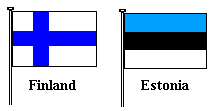 Finland and Estonia
(speaking closely related Uralic languages) enter history as dependencies of
Sweden, then of Russia. Only in the 20th Century do they emerge as independent
countries -- Estonia briefly in the 1920's and 30's and then only after fifty
years of terror (1940-1991) under the Soviet Union.
Finland and Estonia
(speaking closely related Uralic languages) enter history as dependencies of
Sweden, then of Russia. Only in the 20th Century do they emerge as independent
countries -- Estonia briefly in the 1920's and 30's and then only after fifty
years of terror (1940-1991) under the Soviet Union.| Estonia | |
|---|---|
| Konstantinion Päts |
President, 1938-1940 |
| Soviet Occupation, 1940-1941, 1944-1991 | |
| German
Occupation, 1941-1944 | |
| Arnold Rüütel | 1991-1992 |
| Lennart George Meri |
1992-present |
| Iceland | |
|---|---|
| Sveinn Björnsson | 1944-1952 |
| Asgeir Asgeirsson | 1952-1968 |
| Kristjan Eldjarn | 1968-1980 |
| Vigdis Finnbogadottir | 1980-1996 |
| Olafur Ragnar Grimsson |
1996-present |
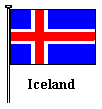 associated with Norway in
1262 and then with Denmark in 1380, became independent, with the King of Denmark
still as the King of Iceland, in 1918, and then a republic, as Denmark was still
occupied by Germany, in 1944. Iceland was occupied as an important Allied base
in World War II. It was also important for observation and logistics in the Cold
War. Surnames preserve active patronymic suffixes, "-son" and "-dottir," as can
be seen in the names of the Presidents.
associated with Norway in
1262 and then with Denmark in 1380, became independent, with the King of Denmark
still as the King of Iceland, in 1918, and then a republic, as Denmark was still
occupied by Germany, in 1944. Iceland was occupied as an important Allied base
in World War II. It was also important for observation and logistics in the Cold
War. Surnames preserve active patronymic suffixes, "-son" and "-dottir," as can
be seen in the names of the Presidents.
Heads of State for the post-World War I nations are taken from the
Regentenlisten und Stammtafeln zur Geschischte Europas by Michael F.
Feldkamp [Philpp Reclam, Stuttgart, 2002].
 |
 |
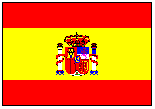 and Portugal
and Portugal 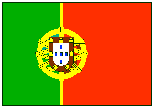 ,
,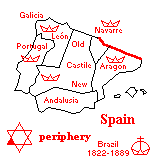 Spain, unlike
Britain, never fell
outside of history after the collapse of the Western Empire, which
gives us a continuous record of rule from Rome through the Visigoths and beyond.
Nevertheless, Spain underwent her own unique transformation in the trauma of the
Islâmic conquest. The Visigoths were crushed
and for almost three centuries a revived Christian kingdom, Asturias, could do
little more than cling to the north coast and the northwest corner of Iberia.
Nevertheless, more than one Christian state eventually organized and gradually
reconquered the peninsula. Navarre (Navarra), Aragón, and Barcelona all began as
march counties of Francia. Asturias/Galicia/León could claim direct succession
from the Visigoths, while Castile (Castilla) was a march of León. There were at
different times up to five different Spanish Christian kingdoms. These were all
eventually consolidated. Portugal, which began as a county of León, was
the only kingdom to ultimately maintain its independence of the rest of Spain.
Spain was sometimes styled an "empire." Ferdinand I and Alfonso VII of Castile
were sometimes styled "Emperor," but in Mediaeval Europe, the Popes regarded such a title as
theirs to dispense, and no self-proclaimed emperors were going to get
cooperation from the Church. In fact, Alfonso X of Castile was
actually elected Holy Roman Emperor in 1257, but nothing came of it all. Alfonso
never went to Germany, distracted by civil war (1275) and rebellion (1282), and
it was already clear that the Pope had no intention of crowning him. When the
Pope finally crowned Emperor a King of Spain, it was Charles V (Charles I of
Spain), a 1/4 German Hapsburg who had been born and raised in Belgium. The
Imperial crown then passed to Charles's brother Ferdinand of Austria, not to his
son Philip II of Spain. [cf. J.H. Elliott, Imperial Spain, 1469-1716,
Mentor, 1963; Adam Wandruszka, The House of Hapsburg, Anchor Books, 1965;
& Denys Hay, Europe in the Fourteenth and Fifteenth Centuries,
Longmans, Green and Co. Ltd., 1966.]
Spain, unlike
Britain, never fell
outside of history after the collapse of the Western Empire, which
gives us a continuous record of rule from Rome through the Visigoths and beyond.
Nevertheless, Spain underwent her own unique transformation in the trauma of the
Islâmic conquest. The Visigoths were crushed
and for almost three centuries a revived Christian kingdom, Asturias, could do
little more than cling to the north coast and the northwest corner of Iberia.
Nevertheless, more than one Christian state eventually organized and gradually
reconquered the peninsula. Navarre (Navarra), Aragón, and Barcelona all began as
march counties of Francia. Asturias/Galicia/León could claim direct succession
from the Visigoths, while Castile (Castilla) was a march of León. There were at
different times up to five different Spanish Christian kingdoms. These were all
eventually consolidated. Portugal, which began as a county of León, was
the only kingdom to ultimately maintain its independence of the rest of Spain.
Spain was sometimes styled an "empire." Ferdinand I and Alfonso VII of Castile
were sometimes styled "Emperor," but in Mediaeval Europe, the Popes regarded such a title as
theirs to dispense, and no self-proclaimed emperors were going to get
cooperation from the Church. In fact, Alfonso X of Castile was
actually elected Holy Roman Emperor in 1257, but nothing came of it all. Alfonso
never went to Germany, distracted by civil war (1275) and rebellion (1282), and
it was already clear that the Pope had no intention of crowning him. When the
Pope finally crowned Emperor a King of Spain, it was Charles V (Charles I of
Spain), a 1/4 German Hapsburg who had been born and raised in Belgium. The
Imperial crown then passed to Charles's brother Ferdinand of Austria, not to his
son Philip II of Spain. [cf. J.H. Elliott, Imperial Spain, 1469-1716,
Mentor, 1963; Adam Wandruszka, The House of Hapsburg, Anchor Books, 1965;
& Denys Hay, Europe in the Fourteenth and Fifteenth Centuries,
Longmans, Green and Co. Ltd., 1966.]
An issue of note concerns the names of the Kings. Since the major languages of Christendom use many of the same names, it is often possible to give translations. This was formerly the most common, so that in English one talked about "Johns" and "Peters" in the Spanish Kingdoms. This is now sometimes frowned upon, but the desire to use the "native" language of the country in question can produce some gaffs: One occasionally sees Kings of Portugal called "Juan," when this is actually just the Spanish, not the Portuguese, version of "John" -- that would be "João." Since there are other languages in the Iberian Peninsula -- Catalan, Basque, and Galician -- besides standard (Castilian) Spanish and Portuguese, it is often a good question just what vernacular language was being used in a particular time and place. There is also the complication that the Kings of Navarre marry into French Royalty and nobility and so after 1234 are all French speaking. The written langugage during much of the period, of course, would just be Latin.
"John" is "Juan" in Castilian, "Xoán" in Galician, "Ion" or "Jon" in Basque, "Joan" in Catalan, "Jean" in French, and "Johannes" in Latin (another form, "Iban," only occurs in the patronymic "Ibañez"). Simply using "John" would seem to be the least confusing and the most revealing. However, Portuguese and Spanish (Castilian) versions are given for most of the names (somewhat irregularly). Some names -- "Alfonso" and "Sancho" -- really do not have English equivalents. Sancho, the name of many Kings of Navarre, is written "Santxo" in Basque and may in fact have originally been a Basque name, though its origin in now obscure ("Santius" was the Latinized version). "Alfonso" becomes "Alphonse" in French, and this has been borrowed into English to an extent, but it is not very common, so "Alfonso," like "Sancho," is simply given in its Spanish form. Sometimes overlooked, again, is that the Portuguese, "Afonso," is different. Another problem is the English equivalent for Castilian "Juana," the feminine form of "Juan." Although this is simply "Jeanne" in French, or "Jone" in Basque, in English it could be "Joan," "Joanna," "Joanne," "Jane," or even "Jeanne." "Ferdinand" and "Fernando" are both of Spanish derivation, originally "Ferdinando." This was itself Visigothic, and the form now most familiar in English, "Ferdinand," is the version of the name as it passed into German with the marriage of Juana the Mad of Castile to Philip of Hapsburg. One of their sons was then the Emperor Ferdinand I. He was raised in Spain, speaking Spanish. His grandfather, Ferdinand II of Aragón, contemplated leaving the kingdom of Aragón to him in his will but thought better of it. Later, he was given the rule of Austria by his brother. Elected king of Hungary and Bohemia, he then succeeded his brother as Emperor.
His brother, of course, was the Emperor Charles V. It is "Charles" in French and English, "Carlos" in Spanish and Portuguese, "Carolus" in Latin, and "Karl" in German. The story about Charles is that he only spoke German to his horse. He was raised at the court of his grandfather, the Emperor Maximilian I, in the Netherlands, speaking Flemish, where his name would be, I think, "Karel," as in Dutch. There is a monument to Charles V in Guadalajara, Mexico. It actually calls him "King Charles V" ("Rey Carlos V"), which is not quite right since, as King of Spain, he was Charles I. All this seems to confuse everybody.
The colors here go with the kingdoms, but as the kingdoms combine, the color of the dominant kingdom supersedes the others. Thus yellow, the color for Castile (which started as a County of León, was detached by Sancho the Great of Navarre, and then was willed to his son Ferdinand I as a separate kingdom), is also the color for Spain as a whole, as Castile absorbs León, Aragón, and then, briefly, Portugal. A minor variation is that the red is darker for the Kingdom of the Asturias, of which León was essentially a continuation. The change in name took place after one of the characteristic divisons and then recombinations, several of which we see later, between brothers, sometimes brothers who become hostile and murderous to each other.
It should be noted that although Spanish Christians later referred to all Spanish, and also North African, Moslems as "Moors," this lumps together ethnically and linguistically distinct peoples, particularly those who were actually Arabs and those who were of North African Berber derivation. There was sometimes tension and conflict between these groups in Islâmic Spain. "Moors" also would mean native Spaniard converts to Islâm, the Muwalladûn. If one then considers sub-Saharan black African Moslems as "Moors," like Shakespeare's Othello, this adds another group, one that would have been noticeable in North Africa but probably not of much significance in Spain. To many people, however, "Moor" always means "black," and this is a serious confusion. Indeed, a factor in the 11th century in Spain were slave troops, the S.aqâliba, that consisted, not of Africans, but of captives from Christian Europe. Also confusing is the tradition of calling Christains in Islâmic Spain "Mozarabs."
Navarre, which is perhaps known too generally by the French version of its name, was originally a kingdom of the Basques, an apparently autochthonous people whose language has no demonstrable affinities to any other in the world, much less to any in the area. Interesting genetic information about this is reported by Luigi Luca Cavalli-Sforza in Genes, Peoples, and Languages [University of California Press, 2000]. The Basque region turns out to be the center of a characteristic gene component of European populations. Cavalli-Sforza says:
...the Basques once inhabited a much larger territory than today... During the last Paleolothic period the Basque region extended over almost the entire area where ancient cave paintings have been found. There are some cues [sic, "clues"?] that Basque descends from a language spoken 35,000 to 40,000 years ago, during the first occupation of France by modern humans... The artists of these caves would have spoken a language of the first, preagricultural Europeans, from which modern Basque is derived. [pp.120-121]
Thus, neither the French nor the Spanish ("Navarra") version of the name of
the kingdom is necessarily more "accurate" than the Basque version,
"Nafarroa." While Navarre was the dominant Spanish kingdom under Sancho
the Great, its power and extent declined quickly and decisively. Of the seven
Basque provinces in Spain and France (where only about 12,000 people speak
Basque any longer), only two ended up belonging to Navarre proper. I have not
noticed Basque nationalists claiming to have invented art (i.e. the cave
paintings), but they apparently would have as reasonable a claim as anyone.
| Islamic Conquest of Spain, Visigoths
Overthrown; Battles of Jerez de la Frontera & Ecija, Cordova captured, 711; Seville & Toledo captured, 712; Battle of Segoyuela, Saragossa (Zaragoza) captured, 713; Valencia captured, 714 | |||
|---|---|---|---|
| Kings of Asturias, at Oviedo |
Arabs stopped in Francia, Battle of Poitiers, 732 | ||
| Pelayo, Pelagius | 718-737 | ||
| Arabs stopped, Battle of Covadonga, 718 | |||
| Favila | 737-739 | Basques, Kings of Navarre, Navarra, Nafarroa | |
| Alfonso I, the Catholic | 739-757 | ||
| Fruela I, the Cruel | 757-768 | ||
| Aurelio, Aurelius | 768-774 | Charlemagne defeated at Roncesvalles, 778 | |
| Silo | 774-783 | ||
| Mauregato, Mauregatus |
783-788 | Iñigo Jimenez | Count, d.822? |
| Vermudo/Bermudo I, the Deacon |
788-791 | Enneco, Iñigo Iniguez Arista |
King, 822- c.851 |
| Alfonso II, the Chaste | 791-842 | County of Barcelona, in Francia, 801 | |
| Nepociano, Nepotian | 842 (?) (852?) |
García I Iniguez | 852- 882 |
| Ramiro I | 842-850 | García (II) Jimenez | rival, d.c.885 |
| Ordoño I | 850-866 | Iñigo Garcés | c.885-? |
| Alfonso III, the Great | 866-910 | Fortuno, Fortun Garcés |
882- 905 |
| Garcia | 910-914 | Sancho I Garcés | 905-925 |
| Ordoño II | Galicia, 910-924 | ||
| 914-924 | |||
| Kings of León | |||
| Fruela II, the Cruel | 924-925 | ||
| Sancho Ordoñez | Galicia, 925-929 |
Jimeno Garcés | 925-931 |
| Alfonso IV, the Monk | 925-931 | ||
| Ramiro II | Galicia, 929-951 |
García II Sánchez I | 931-971 |
| 931-951 | |||
| Ordoño III | 951-955 | Count of Aragón, 922-971 | |
| Sancho I, the Fat | 955-958, 960-966 | ||
| Ordoño IV, the Wicked |
958-960 | Sancho II Gárces II Abarca |
971-994 |
| Ramiro III | 967-982, d.985 | ||
| Vermudo II | 982-999 | García III Sánchez II |
994-c.999 |
| Alfonso V, the Noble | 999-1027 | ||

The names of the early Kings
of Navarre, like those of the early Basque Dukes of Gascony, display the
active use of the patronymic suffix -ez/s. This later becomes conspicuous
in Spanish and Portuguese surnames, but here bespeaks Basque derivation -- like
the names with which it is used, viz. Sancho (Santxo) and García.
Navarre became the suzerain of Aragón in the 9th century. After some
intermarriage, the county was united to Navarre in 971 (or 970). Because of this
process, different events sometimes are referred to by different sources. Thus,
Bruce R. Gordon says that
Navarre acquired Aragón "c.850," but The New Penguin Atlas of Medieval
History says 970 (p.50, note 2). The New Cambridge Medieval History,
Volume III, c.900-c.1024 [Timothy Reuter, editor, Cambridge, 1999] gives the
details [p.689, with the year 970, but then the year 971 on p.717]. There are
other uncertainties about this period. While the picture in Gordon is that the
Asturias was divided among three sons of Alfonso III, ultimately with all
inherited by Alfonso IV, The New Cambridge Medieval History, Volume II,
c.700-c.900 [Rosamond McKitterick, editor, Cambridge, 1995, p. 863] and
Volume III [p. 716] list Ordoño II and Fruela II as successive Kings of León
after Garcia. The details are given in Volume III [pp.674-675]. The independent
(rebellious?) kingdoms in Galicia are the confusing factor. In this period the
capital of the principal kingdom was moved from Oviedo in Asturias to Zamora and
then, perhaps by Ordoño II, to León, which now gives its name to the whole.
The following genealogy was originally derived from Volume III of the Cambridge Medieval History, based on the text where the diagrams [pp.716-717] unaccountably differ. Also, the text refers to the daughter of Sancho García of Castile who marries Sancho III of Navarre as "Mayor" [p.687], even though the diagram calls her "Elvira" and "Mayor" is elsewhere given in the text as the heiress of Ribagorza [p.690]. Now, according to the Erzählende genealogische Stammtafeln zur europäischen Geschichte, Volume II, Part 1, Europäiche Kaiser-, Königs- und Fürstenhäuser I Westeuropa [Andreas Thiele, R. G. Fischer Verlag, Third Edition, 2001], "Munia Mayor"
| Counts of Aragón | |
|---|---|
| Anzar I Galindez | ? |
| García the Bad | d.858 |
| Galindo I Anzárez | 858-c.867 |
| Anzar II Galindez | c.867-c.893 |
| Galindo II Anzárez | c.893-922 |
| Andregoto | Countess, 922-972 |
| annexed by Navarre, 971 | |
The problem of the annexation of Aragón gets muddied a bit further. The
heiress of Aragón, Andregoto (seen elsewhere as "Andregoro"), is shown dying in
972, which looks close (at least) to the dates given by the Cambridge
History and the Penguin Atlas. However, Andregoto's husband, García
II Sanchez of Navarre, already is given, without a date, as Count of Aragón
because of his marriage. This is simple enough, but then García is said to have
divorced (verstoßen) Andregoto circa 940. So did Andregoto remain
Countess of Aragon despite the divorce? The 971 could then be the year that her
son, Sancho II Abarca, inherited Navarre and so, perhaps, also Aragón.
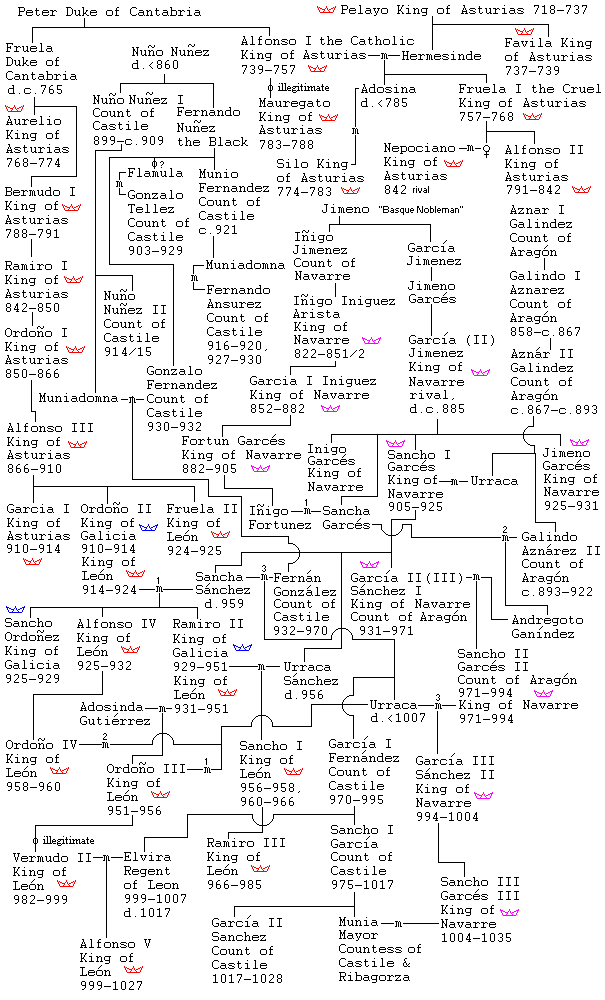
It is notworthy that the lines of Asturias, Castile, and Navarre begin with simultaneous or alternating reigns of rival cousins or even in-laws, i.e. husbands of cousins. How this worked seems clearest in Asturias and most obscure in Castile.
In what follows, before Iberia settles down to just two Kingdoms again (Spain and Portugal), things get very complicated. This is where we get up to five independent Christian thrones -- six counting Barcelona -- not to mention the Moslem states. Thus, the table of rulers has been broken up into more convenient sections. Each section is preceded by maps of the period and followed by a family tree of the rulers. Navarre is given special treatment after the extinction of the Kingdom in Spain. It might be noted that after 1037, every ruler in Christian Spain is a descendant of Sancho III of Navarre.
It should be noted that the Kings of the Asturias, Galicia, León, Castile (Castilla), and Spain (España) share a common numbering, but that the Kings of Navarre, Aragón, and Portugal are all numbered independently. Thus, Sancho II of Navarre (970-994) is different from Sancho II of Aragón (1063-1094), Sancho II of Castile (1065-1072), and Sancho II of Portugal (1223-1245); but Alfonso IX of León (1188-1230) is numbered in succession to Alfonso VIII of Castile (1158-1214).
| Counts of Castile, Castilla, at Burgos | |
|---|---|
| Nuño Nuñez I | 899-c.909 |
| Nuño Nuñez II | 914/15 |
| Gonzalo Tellez | 903-929 |
| Munio Fernandez | c.921 |
| Fernando Ansurez | 916-920, 927-930 |
| Gonzalo Fernandez | 930-932 |
| Fernán(do) González | 932-970 |
| García I Fernandez White Hands |
970-995 |
| Sancho I García Good Laws |
995-1017 |
| García II Sanchez | 1017-1028 |
| annexed by Navarre, 1029 | |
The following period sees the beginning of the Reconquista, the
reconquest of Islâmic Spain by the Christian states. It is certaintly a bad
period for the native Moslem states. Their weakness and divisions make it
possible for Alfonso VI of León and Castile to capture Toledo in 1085, the
traditional beginning of the Reconquista. However, the alarm of Islâm at
this turn drew in the Almoravids (Murabits) from
North Africa, who then defeated Alfonso at Zallâqa in 1086, without, however,
recovering Toledo. This therefore began a new era for Islâmic Spain as well as
for Christian, since native Islâmic Spain was now unable to withstand the
Christians on its own and became dependent on North African powers. The confusions of the period become a source of great romance. When
Alfonso, deposed by his
brother, Sancho II of Castile, returned to power in Castile as well León, he
took on many of Sancho's retainers, including one Rodrigo Díaz (d. 1099).
Rodrigo came to fall out of favor and in 1081 became a mercenary, fighting for
both Christians and Moslems. After taking Valencia in 1094, he passed
into legend as El Cid, interestingly an Arabic title, Sîd, "lord,
master."
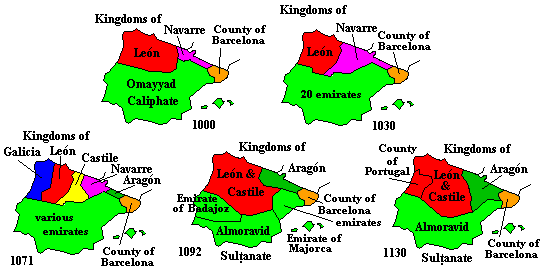
Kings of 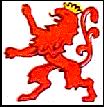 León León |
Kings of 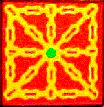 Navarre Navarre | ||||||||
|---|---|---|---|---|---|---|---|---|---|
| Vermudo/Bermudo III | 1027- 1037 |
Sancho I of Aragón |
1000- 1035 | ||||||
Kings of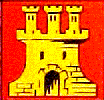 Castile | Kings of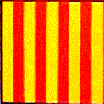 Aragón | García IV Sánchez III | 1035- 1054 | ||||||
| 1037- 1065 | Ferdinand/Fernando I the Great | 1035- 1065 | Ramiro I |
1035- 1063 | |||||
| 1065- 1070, 1072- 1109 |
Alfonso VI | King of Galicia |
Sancho II | 1065- 1072 | Sancho IV | 1054- 1076 | |||
| García | 1065- 1071, 1072- 1073 d.1094 | ||||||||
| 1073-1109 | 1072-1109 | 1063- 1094 | Sancho II Ramirez, Sancho V of Navarre |
1076- 1094 | |||||
| captures Toledo, made capital of
Castile; beginning of the Reconquista, 1085; but defeated by Almoravids, Zallâqa, 1086 | |||||||||
Counts &
Kings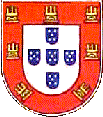 of Portugal |
Urraca (married to Alfonso I of Aragón) | 1109- 1126 | Peter/Pedro I | 1094- 1104 | |||||
| Henry, brother, Odo I of Burgundy |
Count 1093- 1112 |
Alfonso I el
Batallador (co-ruled León & Castile, 1109-1126) |
1104- 1134 | ||||||
| Afonso I | Count 1112- 1139 |
Alfonso VII | Galicia, 1112- 1126 | ||||||
| King 1139- 1185 |
1126- 1157 | occupation of Saragossa, 1118-1130 | |||||||
| Portugal | León | Castile | Aragón | Navarre | |||||
.gif)
In the following period the Almoravid state, which began to weaken, is replaced and the position of Islâmic Spain is restrengthed by a new North African force, the Almohads (Muwahids), who came to Spain in 1147. This respite turns out to be relatively brief. The Christian Kingdoms are growing and occasionally can even cooperate. The Almohads were then crushed at Las Navas de Tolosa in 1212. They had abandoned Spain by 1229, and St. Ferdinand III of Castile and León began to roll up the heart of Andalusia, with Cordova falling in 1235 and Seville in 1248. This would leave only the Sultânate of Granada, in the difficult Sierra Nevada, as a remnant of Islâmic Spain.

| Kings of Portugal | Kings of León | Kings of Castile | Kings of Aragón | Kings of Navarre | |||||
|---|---|---|---|---|---|---|---|---|---|
| Sancho I | 1185- 1211 | Ferdinand II | 1157- 1188 | Sancho III | 1157- 1158 | Ramiro II | 1134- 1137 | Garcia V Ramirez | 1134- 1150 |
| Alfonso VIII | 1158- 1214 | union with County of Barcelona, 1137 | |||||||
| Queen Petronilla | 1137- 1173 | ||||||||
| capture of Saragossa, 1146, new capital of Aragón | |||||||||
| Afonso II | 1211- 1223 | Alfonso IX | 1188- 1230 | Alfonso II |
1173- 1196 | Sancho VI | 1150- 1194 | ||
| defeat by Muwahids at Alarcos, 1195; victory at Las Navas de Tolosa, 1212 |
Pedro II | 1196- 1213 | Sancho VII | 1194- 1234 | |||||
| Sancho II | 1223- 1245 | Henry I | 1214- 1217 | James/ Jaime I |
1213- 1276 | ||||
| 1230- 1252 | St. Ferdinand III San Fernando Rey de España |
1217- 1252 | Thibault, Teobaldo I, of Cham- pagne |
1234- 1253 | |||||
| capture of Cordova, 1235, Seville, 1248 |
capture of Valencia, 1238, Murcia, 1266 |
Thibault, Teobaldo II |
1253- 1270 | ||||||
.gif)
The marriage of Blanca of Navarre to Theobald of Champagne means that for a while the Counts of Champagne become the Kings of Navarre. Greater detail of that genealogy can be examined on the page for Champagne. What this leads to is examined further below.
In the following period the Reconquista is completed, and Spain,
unified, becomes a World Power, perhaps truly the first such, as Spanish sailors
circle the planet and claim most of it, with the claims sticking in much of the
New World, the Philippines, and elsewhere -- even as the inheritance of the
united Kingdom by the Hapsburgs made Spain a partner to the dominant political
forces of Catholic Europe. 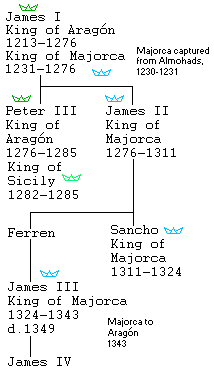 One detail noticeable on the maps but not thoroughly indicated in
the table or genealogy below (but shown at right) is the temporary Aragonese
Kingdom of Majorca, conquered from the Almohads and then left to a brother,
James II, of Peter III. Eventually, Peter IV disposessed his cousin and returned
the islands to Aragón (1343).
One detail noticeable on the maps but not thoroughly indicated in
the table or genealogy below (but shown at right) is the temporary Aragonese
Kingdom of Majorca, conquered from the Almohads and then left to a brother,
James II, of Peter III. Eventually, Peter IV disposessed his cousin and returned
the islands to Aragón (1343).
Meanwhile, with the competion of the Reconquista, there was the nagging problem of the non-Christians, the Jews and Moslems, who were scooped up in the new possessions. There had already been forced conversions of Jews, both by Christians and by the Almoravids and Almohads. Some Jews, like Moses Maimonides (1135-1204), had seen the handwriting on the wall back then and left. Under Christian rule, however, many Jews had converted -- the Conversos. Christians often suspected, correctly, that many Conversos were still secretly practicing Judaism. These were derisively called Marranos, perhaps derived from a Spanish word for "swine." The Spanish Inquisition in great measure was created to test the faith of Marranos, many of whom were burned at the stake or otherwise punished for the actual or suspected practice of Judaism. In the fateful year of 1492, the religious problem was taken up a couple of notches. After a long and hard campaign, Granada surrendered, finishing the Reconquista. The last Sult.ân left for North Africa, but one condition of the surrender was religious toleration for Moslems. This was not going to last long, only until 1499. By 1502, Moslems of Granada were supposed to accept baptism or leave; and by 1526 this was the choice for the last Moslems of Valencia and Aragón. Those who remained and converted were the Moriscos, who thus joined the Marranos as suspected crypto-infidels. Meanwhile in 1492, Ferdinand and Isabella decided to expel all unconverted Jews from Spain. Portugal followed suit in 1497 and Navarre in 1498. Jews went to North Africa, distant Turkey, the Netherlands, and other places. Those who remained and converted, of course, were now open to the tender investigations of the Inquisition. The greater threat to the regime, however, seemed to be the Moriscos, who continued to speak Arabic and retained their traditional garb and customs. They were occasionally ordered to stop and assimilate. These orders were generally ignored, but as the Spanish state strengthened, the threat became more serious. The enforcement of a 1566 (or 1567) order finally provoked a Revolt at the end of 1568. With the Turkish navy contesting the Mediterranean, and crypto-Moslem Moriscos calling for help, the Revolt became part of the larger contest with Islâm that troubled Philip II. With much hard fighting, and even subsequent years of guerrilla actions, the Revolt was largely suppressed in 1570. Philip decided to remove the remaining Moriscos from Granada and scattered them throughout Spain. This ended their threat as a serious internal enemy, but it did not end their existence as a cultural and religious irritation. The suspicion of Marranos and Moriscos by the Church and the Crown poisoned Spain for many years. In so far as the Moriscos were concerned, however, this didn't last too long, since Philip III decided in 1609 to expell them from Spain altogether, whether they were really Christians or not. This was accomplished by 1614, after which only the persecution of Marranos would continue. Many of them, rather than fleeing Spain altogether, moved to the Spanish colonies in the New World, where their exalted status over the Indians made their disabilities back home less conspicuous and significant. Astonishingly, even today some families surivive in New Mexico with the memory, passed down the generations, that they had once been Jews. The deliberate destruction of the Jewish and Moslem communities in Spain, however, was no help to Spain either culturally or economically. As the Arab historian Philip Hitti said, Spain shone for a few years with a "borrowed glory" from its creative mediaeval communites, but then sank into the status of a cultural and political backwater all the way into the 20th century.
For a good part of the following period the royal houses of Spain and Portugal were both illegitimate: Trastámara and Avis. Also, John of Avis had an illegitimate son, the Duke of Braganza, who leads to the Kings of Portugal after Spanish rule is overthrown in 1640. Also noteworthy is the fact that Queen Isabella of León and Castile usurped the throne of her niece, Joanna la Beltraneja. Isabella's half-brother, Henry IV, was called "the Impotent" because this is what his first wife, Blanche of Navarre, said. He cannot have been completely impotent, however, since his second wife had Joanna. Later, although Joanna the Mad (Juana la Loca) is only listed as Queen until 1516, she was actually titular Queen until her death in 1555. But since Charles I (V) was both Regent and Heir, and Emperor, he is usually simply regarded as the de facto King.
A 2001 movie, Juana la Loca, was Spain's nominee for the Academy Award
for Best Foreign Film. It did not make the final list of five nominees, however.
I have not seen the movie yet and cannot say whether it is of historical
interest.
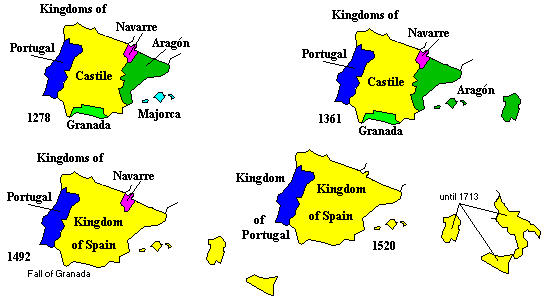
| Kings of Portugal | Kings of Castile | Kings of Aragón | Kings of Navarre | ||||||
|---|---|---|---|---|---|---|---|---|---|
| Afonso III | 1245- 1279 | Alfonso X, the Emperor, the Learned, the Wise | 1252- 1284 | Peter/ Pedro III |
1276- 1285 | Henry I | 1270- 1274 | ||
| King of Sicily, 1282- 1285 |
Jeanne/ Juana I |
1274- 1305 | |||||||
| Diniz/ Dinis |
1279- 1325 | Sancho IV | 1284- 1295 | Alfonso III | 1285- 1291 | ||||
| Ferdinand IV | 1295- 1312 | James II | 1291- 1327 | Luis, Louis X of France |
1305- 1314 | ||||
| Sardinia ceded by Pisa, 1326 | France, 1314- 1316 | ||||||||
| Afonso IV | 1325- 1357 | Alfonso XI | 1312- 1350 | Alfonso IV | 1327- 1336 | Philip I, V of France |
1314- 1322 | ||
| Charles I, IV of France |
1322- 1328 | ||||||||
| Peter/ Pedro I |
1357- 1367 | Peter the Cruel | 1350- 1366, 1367- 1369 |
Peter IV | 1336- 1387 | Jeanne/ Juana II |
1328- 1349 | ||
| Ferdinand/ Fernando I |
1367- 1383 | Henry/ Enrique II |
1366- 1367, 1369- 1379 |
Philip II, d'Evreux |
1328- 1343 | ||||
| John/ João I of Avis |
1385- 1433 | John/ Juan I |
1379- 1390 | John/ Juan I |
1387- 1395 | Charles II, the Bad | 1349- 1387 | ||
| Henry III | 1390- 1406 | Martin I | 1395- 1410 | Charles III, the Noble | 1387- 1425 | ||||
| Edward/ Duarte I |
1433- 1438 | John II | 1406- 1454 | Ferdinand I | 1412- 1416 | Blanche/ Blanca |
1425- 1441 | ||
| Alfonso V | 1416- 1458 | ||||||||
| King of Naples, 1442- 1458 | |||||||||
| Afonso V | 1438- 1481 | Henry IV | 1454- 1474 | 1458- 1479 | John II | 1425- 1479 | |||
| John/ João II |
1481- 1495 | Isabella/ Isabel I |
1474- 1504 | 1479- 1516 | Ferdinand II; Ferdinand V of Castile / Spain; Ferdinand of Navarre |
Eleanor/ Leonora |
1479 | ||
| fall of Granada, end of Reconquista, 1492 | François Phébus/ Francisco Febo |
1479- 1483 | |||||||
| Emanuel/ Manuel I |
1495- 1521 | Juana the Mad (d. 1555; & Philip I, of Hapsburg, d. 1506) |
1504- 1516 | Regent of Castile, 1506- 1516 | Catherine/ Catalina |
1483- 1512, d.1517 | |||
| 1512- 1516 | |||||||||
| John/ João III |
1521- 1557 |
d. 1558 |
1516- 1556 | ||||||
| Sebastian/ Sebastião I |
1557- 1578 |
|
1556- 1598 | ||||||
| Cardinal Henry/ Henrique |
1578- 1580 | ||||||||
| 1580- 1598 | |||||||||
|
|
1598- 1621 | ||||||||
.gif)
Spanish and Portuguse Colonial Possessions
| Kings of Navarre | |
|---|---|
| Catherine/Catalina | 1483-1517 |
| John III d'Albret | 1484-1516 |
| Henry II | 1517-1555 |
| Jeanne III | 1555-1572 |
| Anthony de Bourbon Duke of Vendôme |
1555-1562 |
| Huguenot leader, dies of wounds, 1562 | |
| Henry III, Henry IV of France |
1572-1610 |
| King of France, 1589-1610 | |
The large genealogical chart, Kings & Queens of Europe, compiled
by Anne Tauté [University of North Carolina Press, 1989], simply ends the line
of Navarre with Jeanne I. For a long time, the only family tree I had seen of
subsequent rulers was in Europe in the Fourteenth and Fifteenth Centures,
by Denys Hay [Longmans, London, 1966, p. 404], which ends with Queen Catherine,
who lost the Kingdom to Ferdinand. Family trees for the Bourbons, such as given
here, almost never go
back further than the father, Henry, of Henry IV's mother Jeanne. Brian
Tompsett's Royal and Noble genealogy originally enabled me to fill in the
gaps, but there are some obscurities and questions in the information of both
Tompsett and Hay that I had to compare with other sources. The first complete
list of the Kings of Navarre I have found is in the Regentenlisten und
Stammtafeln zur Geschichte Europas by Michael F. Feldkamp [Philipp Reclam,
Stuttgart, 2002, pp.146-148]. A complete genealogy can now be found in the
Erzählende genealogische Stammtafeln zur europäischen Geschichte, Volume
II Part 1, Europäische Kaiser-, Königs, und Fürstenhäuser I Westeuropa,
by Andreas Thiele [R.G. Fischer Verlag, 2001, p.185-192].
The most striking thing about the succession for Navarre is that the last Capetian Kings of France,
Louis X to Charles IV, were all Kings of Navarre. John I doesn't seem to get
counted as a King of Navarre, but then, only reigning eight days, he is
sometimes not even counted as a King of France --  on the other hand, it may be
necessary to count him if the husband of Catherine is to be counted as John III
of Navarre, which means that John II of Aragón was also John II of Navarre --
there was no earlier John (Jean/Juan) in Navarre to be John I, if not the
Capetian. With the death of Charles IV (Charles I of Navarre), a curious thing
happens. The succession of France jumps to the House of Valois, but, as it
happened, Louis X had a surviving daughter, Jeanne. She was ignored for the
French Throne because of the Salic Law, which prohibited female
succession, but the Salic Law did not apply to Navarre. So while the
French Thone passed to Philip VI in 1328, the Throne of Navarre passed to
Jeanne/Juana (II).
on the other hand, it may be
necessary to count him if the husband of Catherine is to be counted as John III
of Navarre, which means that John II of Aragón was also John II of Navarre --
there was no earlier John (Jean/Juan) in Navarre to be John I, if not the
Capetian. With the death of Charles IV (Charles I of Navarre), a curious thing
happens. The succession of France jumps to the House of Valois, but, as it
happened, Louis X had a surviving daughter, Jeanne. She was ignored for the
French Throne because of the Salic Law, which prohibited female
succession, but the Salic Law did not apply to Navarre. So while the
French Thone passed to Philip VI in 1328, the Throne of Navarre passed to
Jeanne/Juana (II).
Jeanne's son was Charles "the Bad." A lengthy account of his doings can be found in Barbara Tuchman's A Distant Mirror [Ballantine, 1978], which is about the events of the 14th century. The County of Evreux, which he inherited from his father, was in Normandy, which means he spent a great deal of his life in intrigues very distant from the Pyrenees.
Two generations later, we get to Queen Blanche/Blanca, who marries Spanish rather than French, namely the future King of Aragón, John II. After Blanche's death John remarries. He then outlives all of Blanche's children but one, Eleanor/Leonora. Aragón goes to a son, Ferdinand, by his second marriage, but Navarre passes to Leonora, who does not survive the year. Her husband, Count Gaston of Foix, and her son, Gaston also, both predeceased her, so the succession passes to her grandson, Francis Phoebus (François Phébus in French; Francisco Febo in Spanish), and then her granddaughter, Catherine/Catalina. Here I had a question, because Hay shows two Gastons in between Leonora and Catherine. This seemed to be a mistake, and I followed Brian Tompsett. I have now been able to confirm this with the Erzählende genealogische Stammtafeln zur europäischen Geschichte, Volume II Part 1, Europäische Kaiser-, Königs, und Fürstenhäuser I Westeuropa, by Andreas Thiele [R.G. Fischer Verlag, 2001, p.191].
What Tompsett didn't have in his database was the young (23) Gaston de Foix,
Duke of Nemours, who was killed at the battle of Ravenna in 1512. Elsewhere on
the Web, Gaston was listed as a son of Jean de Foix and a grandson of Gaston IV
of Foix and Eleanore (Leonora) of Aragón. So I took it that Gaston and Leonora
had at least two sons, though I had no sources that listed them both. Now,
however, I do, since the Erzählende genealogische Stammtafeln
[ibid., p.191] shows not only this, but that Gaston and Leonora had four
sons and five daughters. Gaston's mother was Marie d'Orléans, a sister of King
Louis XII of France.
Catherine now married French nobility again, this time John of Albret. The
two of them were doomed to suffer from the ambition of her cousin, Ferdinand of
Aragón, who invaded Navarre in 1512 and got the Pope to officially dethrone
Catherine and John and certify the transfer. In 1515 Ferdinand, who had joined
Navarre to the Crown of Aragón, transfered it to that of Castile, lest the
Navarrese claim the extra privileges enjoyed by the Aragonese. A small part of
Navarre north of Pyrenees, Lower Navarre ("Basse Navarre" in French or
"Nafarroa Beherea" in Basque), was retroceded by Charles V in 1530, so a
landed Monarchy continued, with, of course, its growing French holdings. The
table also shows an interesting alliance of the d'Albret family. John's sister
Charlotte married Cesare Borgia, though he abandoned the marriage after four
months. The succession then passes to Henry II. Here Tompsett had a question,
since he gave Henry as the grandson of Catherine but then noted
obscurities over Catherine's son, named Henry also. The Encyclopaedia Britannica flatly states that Henry
II himself was the son of Catherine and John d'Albret, so I followed
that. This construction is confirmed by the Erzählende genealogische
Stammtafeln [ibid., p.192].
Henry II marries a sister, Margaret, of King Francis I of France. She is
somewhat celebrated, as Margaret (or Marquerite) of Navarre (or of Angoulême),
patroness of Rabelais and author of a collection of stories, the
Heptameron. Henry's daughter, Jeanne (III), then marries the senior heir
of the Bourbons, Anthony (Antoine), Duke of Vendôme. 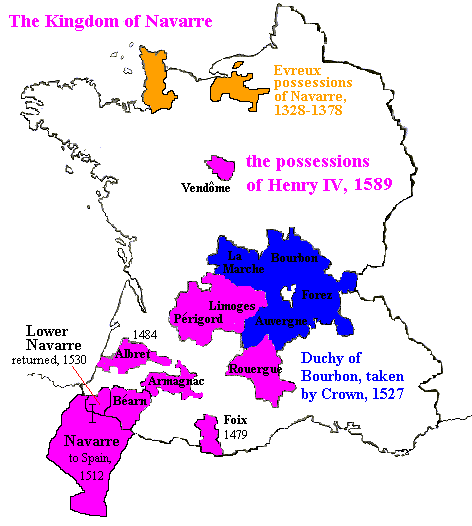 Their son, Henry III of
Navarre, becomes heir to the French Throne, claiming it, amid civil war, in
1589, as Henry IV. After 261 years, the Thrones of France and Navarre are again
joined.
Their son, Henry III of
Navarre, becomes heir to the French Throne, claiming it, amid civil war, in
1589, as Henry IV. After 261 years, the Thrones of France and Navarre are again
joined.
The map at left shows the lands that Henry brought to the French Monarchy. We
have seen how Foix, Albret, and Vendôme accrued to Navarre, and how most of
Navarre proper was lost to Spain. It is noteworthy that the blue territories,
previously belonging to the Dukes of Bourbon, who were separate from Henry's
line, had previously reverted to the French Throne. The outline of France shown
is slightly unfamiliar because Savoy, Alsace, Lorraine, and the Free County of
Burgundy have not yet been added to France's eastern frontier.
| The Heiresses of Navarre | |||
|---|---|---|---|
| Heiress | Husband | ||
| Blanca | d.1229 | Theobald of Champagne |
d.1201 |
| Jeanne I | Queen, 1274-1305 |
Philip IV of France |
France, 1285-1314 |
| Jeanne II | Queen, 1328-1349 |
Philip of Evreux |
Navarre, 1328-1343 |
| Blanca | Queen, 1425-1441 |
John II of Aragón |
Navarre, 1425-1479 |
| Aragón, 1459-1479 | |||
| Leonora | Queen, 1479 |
Gaston IV of Foix |
d.1472 |
| Catherine | Queen, 1483-1517 |
John III d'Albret |
Navarre, 1484-1516 |
| Jeanne III | Queen, 1555-1572 |
Anthony of Bourbon |
Navarre, 1555-1562 |
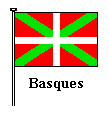 On the other hand, the
national consciousness of the Basque people continues to trouble the unity of
the nation states. Besides Spanish Navarra and French Lower Navarre, two other
Basque provinces, Labourd and La Soule, exist in France, and three others,
Vizcaya, Guipúzcoa, and Alava, exist in Spain. The capital of Spanish Navarra,
Pamplona (from Latin Pompeiopolis or Pampaelo), Iruña in
Basque, is famous for the annual running of the bulls; but Basque nationalism
has a more troubling aspect in Spain, with a long and continuing campaign of
terrorist attacks to the credit of the extremists. Thus, Navarre and the Basque
country have a significance far beyond their size in both mediaeval and modern
history.
On the other hand, the
national consciousness of the Basque people continues to trouble the unity of
the nation states. Besides Spanish Navarra and French Lower Navarre, two other
Basque provinces, Labourd and La Soule, exist in France, and three others,
Vizcaya, Guipúzcoa, and Alava, exist in Spain. The capital of Spanish Navarra,
Pamplona (from Latin Pompeiopolis or Pampaelo), Iruña in
Basque, is famous for the annual running of the bulls; but Basque nationalism
has a more troubling aspect in Spain, with a long and continuing campaign of
terrorist attacks to the credit of the extremists. Thus, Navarre and the Basque
country have a significance far beyond their size in both mediaeval and modern
history. .gif)
| Portugal | Spain | ||
|---|---|---|---|
| 1621- 1640 |
Philip III of Portugal |
1621- 1665 | |
| Revolt of Portugal, 1640; Revolt of Catalonia, 1640-1659 | |||
| John/João IV of Braganza/ Bragança |
1640- 1656 | defeat at Rocroi by France, end of Spanish hegemony, 1643 | |
| Afonso VI d. 1683 |
1656-1667 | Charles/ Carlos II |
1665-1700 |
| Peter/ Pedro II |
1667-1706 | ||
| John/ João V |
1706-1750 | Philip of Anjou/Felipe V de Borbón |
1700-1746 |
| War of the Spanish Succession, 1701-1714 | |||
| Joseph Emanuel/ José Manuel |
1750-1777 | Ferdinand VI | 1746-1759 |
| Charles III | King of Sicily, 1734-1759 | ||
| 1759-1788 | |||
| Maria I | 1777-1816 | Charles IV | 1788-1808 |
| Peter/ Pedro III |
1777-1786 | ||
| John/ João VI |
Regent 1799-1816 |
Ferdinand/ Fernando VII |
1808 |
| French Occupy Portugal & Spain, 1807 | |||
| in Brazil 1807-1821 |
Joseph Bonaparte |
1808-1814 | |
| 1816-1826 | Ferdinand VII, restored |
1814-1833 | |
| Peter/Pedro IV / Peter I of Brazil |
1826 | ||
| Emperor of Brazil 1822-1831 | |||
| Maria II | 1826-1828 1834-1853 | ||
| Peter/Pedro II Emperor of Brazil |
1831-1889 | Isabella/ Isabel II |
1833-1868 |
| Ferdiniand/ Fernando II |
1837-1853 | ||
| Miguël | 1828-1834 | ||
| Peter/ Pedro V |
1853-1861 | ||
| Louis/Luis | 1861-1889 | First Republic, 1868-1871 | |
| Amadeo of Savoy |
1871-1873 | ||
| Alfonso XII | 1874-1885 | ||
| Charles/ Carlos |
1889-1908 | Alfonso XIII | 1886-1931 |
| Manuel II | 1908-1910 d. 1932 | ||
| Republic, 1910-1926 | |||
| Provisional President | |||
| Theophilo Braga | 1910-1911 | ||
| President | |||
| Manoel de Arriaga |
1911-1915 | ||
| Gen. Pimenta de Castro |
1915 | ||
| Bernardino Machado |
1915-1917 | ||
| Gen. Sidonio Pães | 1917-1918 | ||
| Antoio José de Almeida |
1919-1925 | ||
| Bernardino Machado |
1925-1926 | ||

.gif)
| Portugal | Spain | ||||||
|---|---|---|---|---|---|---|---|
| Fascist Dictatorship, 1932-1974 |
Second Republic, 1931-1939 | ||||||
| President | Prime Minister | President | |||||
| António Óscar de Fragoso Carmona | 1926-1951 | António de Oliveira Salazar | 1932-1968 | Alcalá Zamora | 1931-1936 | ||
| Manuel Azaña | 1936-1939 | ||||||
| Spanish Civil War, 1936-1939 | |||||||
| Fascist Dictatorship, 1936-1975 | |||||||
| Francisco Franco | 1936-1975 | ||||||
| Francisco Higino Craveiro Lopes | 1951-1958 | ||||||
| Américo de Deus Rodrigues Tomás | 1958-1974 | Marcelo Caetano | 1968-1974 | ||||
| Republic, 1974-present | |||||||
| António de Spínola | 1974 | Adelino da Palma Carlos | 1974 | ||||
| Francisco da Costa Gomes | 1974-1976 | Vasco dos Santos Gonçalves | 1974-1975 | Prime Minister | |||
| Monarchy Restored | Carlos Arias Navarro | 1973-1976 | |||||
| José Batista Pinheiro de Azevedo | 1975-1976 | Juan Carlos | 1975- | ||||
| António dos Santos Ramalho Eanes | 1976-1986 | Mário Soares | 1976-1978 | Adolfo Suárez González | 1976-1981 | ||
| Alfredo Nobre da Costa | 1978 | ||||||
| Carlos Mota Pinto | 1978-1979 | ||||||
| Maria de Lurdes Pintassilgo | 1979-1980 | ||||||
| Francisco Sá Carneiro | 1980 | ||||||
| Francisco Pinto Balsemão | 1980-1983 | Leopoldo Calvo Sotelo y Bustelo | 1981-1982 | ||||
| Mário Soares | 1983-1985 | Felipe González Márquez | 1982-1996 | ||||
| Mário Soares | 1986-1996 | Aníbal Cavaço Silva | 1985-1995 | ||||
| Jorge Sampaio | 1996- | António Guterres | 1995- | José María Aznar Lopez | 1996- | ||
The deaths of both Spanish and Portugese dictators then ushered in the first real periods of democracy in the history of either country. The socialist, if not the communist, temptation was still here, but King Juan Carlos held off conservative coups in Spain, and the people of both countries came a bit more to their senses, although still burdened with the false ideals of Euro-socialist regimes like France. With a long history of trying to ignore the government, as in Italy, the Spanish economy may have been healthier, thanks to off-the-books transactions, than other statistics (like official unemployment, 22.5%) might have shown. Nevertheless, this still imposed a cultural as well as a political burden on Spain and Portugal really rising to a competitive level in the world economy. Now, however, Prime Minster Aznar has begun to be spoken of together with Ronald Reagan and Margaret Thatcher. Slashing taxes in 1997, the Spanish economy kicked up quickly. Although the 2001 (official) unemployment rate, at 14%, is still virtually a Depression level, the economy is growing at over 3% a year, almost twice as quickly as France. This may be just what Spain needs to join the ranks of heathiest economies, as well as healthiest democracies.
Ferdinand I's Kingdom of Castile was divided between his three sons: Sancho II received Castile, Alfonso VI, León, and a new Kingdom of Galicia was broken off León for García. However, Sancho II prevented García from taking up his kingdom and then proceeded to attack Alfonso VI. In 1070, Sancho actually defeated Alfonso and drove him into exile, reassembling the whole kingdom of Ferdinand I. But when Sancho was killed in 1072, the whole kingdom immediately fell to Alfonso, who maintained its unity by imprisoning García until his death. How Sancho was killed is still a matter of uncertainty. He seems to have been meeting an incursion from Alfonso in exile, but the death may have been one of betrayal than just of battle. Whether Alfonso was even present is variously represented.
St. Ferdinand III was 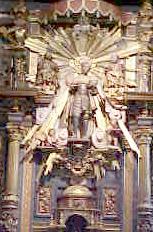 the King of Castile and León responsible for the conquest of the
heartland of Islâmic Spain: Andalusia. "San Fernando Rey de España"
was the name given to one of the Franciscan missions in California -- the King is
shown, at right, in glory above the altar of the Mission. From it is derived the
name of the San
Fernando Valley, which is largely occupied by the City of Los
Angeles, together with the independent cities of San Fernando, Burbank,
Glendale, and Calabasas. Near the center of the Valley is Los Angeles Valley College, the
mailing address for The Proceedings of the
Friesian School, Fourth Series. The San Fernando Valley is ringed by the
Santa Monica, Santa Susana, San Gabriel, and Verdugo Mountains and the
Chatsworth and Hollywood Hills. The Los Angeles River rises in the Valley
and flows out through Burbank and Glendale. Although the River normally runs
nearly dry, flash floods do occur occasionally during the winter. A flood
control network consequently was constructed after devastating flooding in 1938.
The most conspicuous feature in the network is the Sepulveda Dam, which
has been used in countless movies, television shows, and commercials to
represent, not just dams, but military fortifications or even prisons as well.
the King of Castile and León responsible for the conquest of the
heartland of Islâmic Spain: Andalusia. "San Fernando Rey de España"
was the name given to one of the Franciscan missions in California -- the King is
shown, at right, in glory above the altar of the Mission. From it is derived the
name of the San
Fernando Valley, which is largely occupied by the City of Los
Angeles, together with the independent cities of San Fernando, Burbank,
Glendale, and Calabasas. Near the center of the Valley is Los Angeles Valley College, the
mailing address for The Proceedings of the
Friesian School, Fourth Series. The San Fernando Valley is ringed by the
Santa Monica, Santa Susana, San Gabriel, and Verdugo Mountains and the
Chatsworth and Hollywood Hills. The Los Angeles River rises in the Valley
and flows out through Burbank and Glendale. Although the River normally runs
nearly dry, flash floods do occur occasionally during the winter. A flood
control network consequently was constructed after devastating flooding in 1938.
The most conspicuous feature in the network is the Sepulveda Dam, which
has been used in countless movies, television shows, and commercials to
represent, not just dams, but military fortifications or even prisons as well.